Paul van Yperen's Blog, page 70
October 27, 2023
John Boles
John Boles (1895-1969) was an American singer and actor best known for playing Victor Moritz in the Horror classic Frankenstein (1931). He started out in Hollywood in silent films but became a huge star with the advent of talkies.
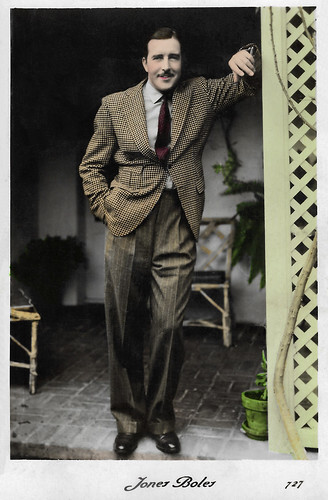
French postcard, no. 727.
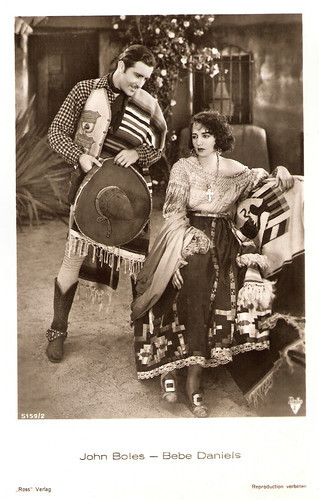
German postcard by Ross Verlag, no. 51592, 1930-1931. Photo: Radio Pictures (RKO). Bebe Daniels and John Boles in Rio Rita (Luther Reed, 1929).
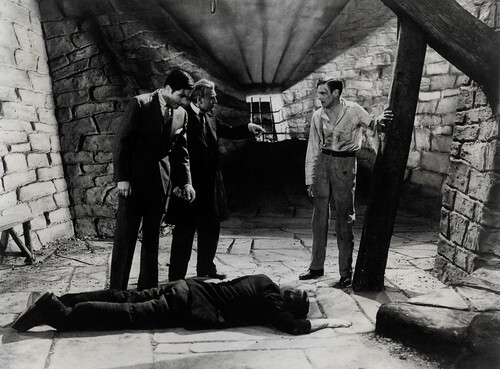
Vintage photo. John Boles, Edward Van Sloan, Colin Clive and Boris Karloff in Frankenstein (James Whale, 1931).
Audiences were enthralled by his beautiful voice
John Boles was born in Greenville, Texas, to a middle-class family. He graduated from the University of Texas in 1917. Boles served in the intelligence service of the U.S. Army during World War I. He returned to Greenville, where he was selected by an out-of-town producer to act in an opera at the King Opera House. This experience convinced John that he preferred music and the stage to the preference of his parents, who wanted him to pursue a medical degree.
While en route to a career as an actor and singer, Boles earned a living by teaching French and singing in a high school in New York State and working as a business manager and interpreter for a one-year tour of Europe by a student group. The latter venture led to his studying under tenor Jean de Reszke. Boles married Marcelite Dobbs in 1917, and they remained married until his death.
After the First World War, Boles moved to New York to study music. He quickly became well-known for his talents and was selected to replace the leading man in the 1923 Broadway musical 'Little Jesse James'. He became an established star on Broadway. Boles' other Broadway credits include 'Mercenary Mary' (1924), and 'Kitty's Kisses' (1925). It attracted the attention of Hollywood producers.
He was hired by MGM to appear in the silent film The Sixth Commandment (Christy Cabanne, 1924). He starred in two more films for that studio before returning to New York and the stage. In 1927, he returned to Hollywood to star in The Love of Sunya (Albert Parker, 1927) opposite Gloria Swanson , which was a big success for him. Unfortunately, because the movies were still silent he was unable to show off his singing ability.
In 1929, Warner Brothers hired him to star in their lavish musical operetta The Desert Song (Roy Del Ruth, 1929). This film featured sequences in Technicolor and was a box-office success. Soon after, Radio Pictures (later known as RKO) selected him to play the leading man in their extravagant production Rio Rita (Luther Reed, 1929), opposite Bebe Daniels . The last portion of the film was photographed in Technicolor. Audiences were enthralled by his beautiful voice, and John Boles suddenly found himself in huge demand. RCA Victor even hired him to make phonograph records of songs that he had sung in his films.
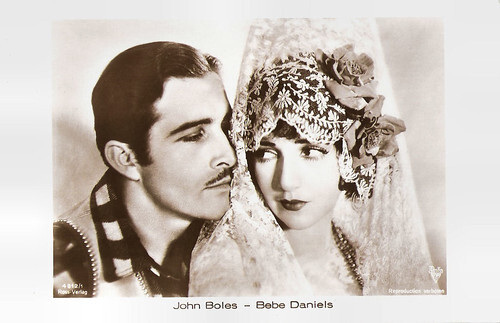
German postcard by Ross Verlag, no. 4812/1, 1929-1930. Photo: Radio Pictures (RKO). Bebe Daniels and John Boles in Rio Rita (Luther Reed, 1929).
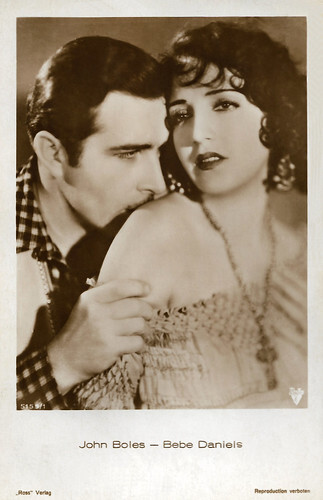
German postcard by Ross Verlag, no. 5159/1, 1930-1931. Photo: Radio (R.K.O.) John Boles and Bebe Daniels in Rio Rita (John G. Blystone, 1929).
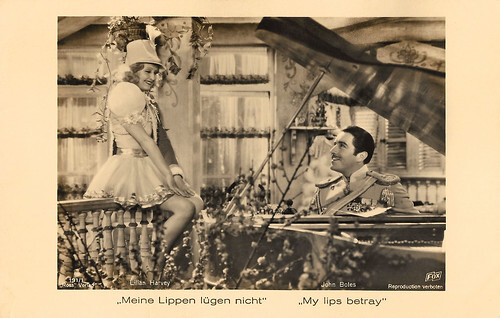
German postcard by Ross Verlag, no. 191/1, 1932-1933. Photo: Fox. Lilian Harvey and John Boles in My Lips Betray (John G. Blystone, 1933).
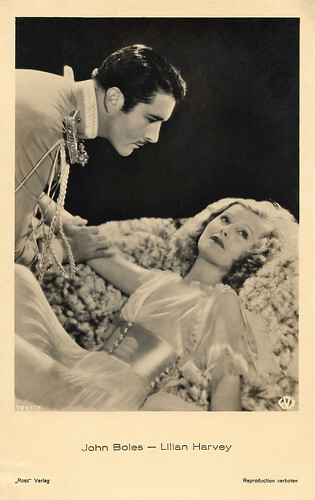
German postcard by Ross Verlag, no. 7993/2, 1932-1933. Photo: Fox. Lilian Harvey and John Boles in My Lips Betray (John G. Blystone, 1933).
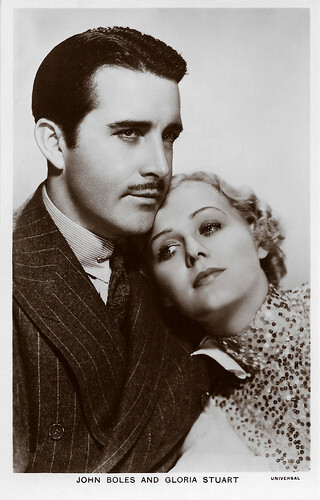
British postcard in the Film Partners Series, London, no. P 142. John Boles and Gloria Stuart in Beloved (Victor Schertzinger, 1934).
An even more extravagant musical
As soon as Rio Rita was completed, John Boles went back to Warner Brothers as the leading man in an even more extravagant musical entitled Song of the West (Ray Enright, 1930) that was filmed entirely in Technicolor. Shortly after this film, Universal Pictures offered John Boles a contract, which he accepted. He starred in a number of pictures for them, most notably the all-Technicolor musical revue entitled The King of Jazz (John Murray Anderson, 1930) and a historical operetta entitled Captain of the Guard (John S. Robertson, Pál Fejös, 1930) opposite Laura La Plante .
In 1931, he starred with Evelyn Laye in One Heavenly Night (George Fitzmaurice, 1931), which would prove to be his last major musical. Boles portrayed Victor Moritz in Frankenstein (James Whale, 1931). He starred with Irene Dunne in a film adaptation of Edith Wharton's 1920 novel 'The Age of Innocence' (Philip Moeller, 1934) for RKO Radio Pictures.
He had another leading part opposite Gloria Swanson , this time as her bickering beau in Music in the Air (Joe May, 1934) and he took the role of Edward Morgan in Curly Top (Irving Cummings, 1935), starring Shirley Temple . Freelancing after his Fox contract ended in 1936, Boles experienced a dip in popularity. Then Boles played a strong part alongside Barbara Stanwyck in the classic Stella Dallas (King Vidor, 1937).
In 1943, Boles played the role of a colonel in the star-studded Thousands Cheer (George Sidney, 1943). By this point, his film career had declined and he returned to the stage. On Broadway, he co-starred with Mary Martin and Kenny Baker in 'One Touch of Venus' (1943), a musical with music written by Kurt Weill, lyrics by Ogden Nash, and a book by S. J. Perelman and Nash. Boles retired from the screen and stage in 1952, after one more film, the low-budget farce Babes in Baghdad (Edgar G. Ulmer, 1952), wherein, according to AllMovie , he was "trapped with fellow faded luminaries Paulette Goddard and Gypsy Rose Lee".
John Boles later went into the oil business and lived the last 13 years of his life in San Angelo, Texas. For his contributions to the film industry, Boles was inducted into the Hollywood Walk of Fame in 1960 with a motion pictures star located at 6530 Hollywood Boulevard. Boles died of a heart attack in 1969, in San Angelo, Texas, at age 73. He and his wife Marcelite are interred at Westwood Memorial Park in Los Angeles. The couple had two daughters: Frances and Janet.
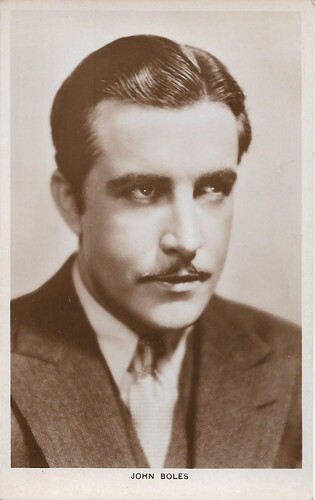
British postcard.
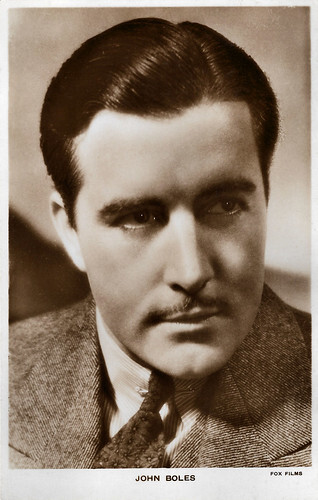
British postcard. Photo: Fox Films.
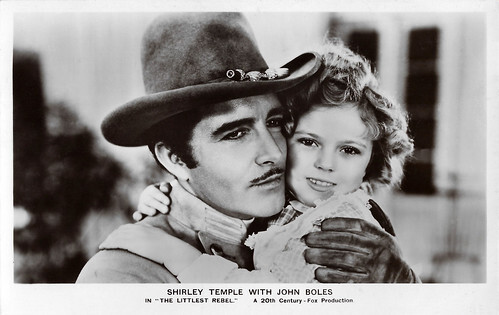
British postcard, no. FS 17. Photo: 20th Century Fox. Shirley Temple and John Boles in The Littlest Rebel (David Butler, 1935).
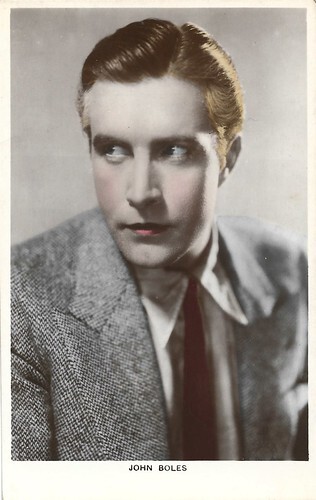
British postcard in the Colourgraph Series, London, no. C.20.
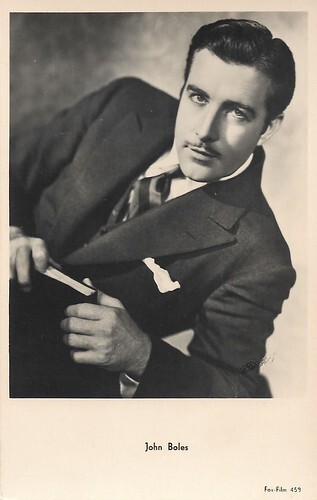
Dutch postcard, no. 459. Photo: Fox Film.
Sources: AllMovie, Wikipedia and .

French postcard, no. 727.

German postcard by Ross Verlag, no. 51592, 1930-1931. Photo: Radio Pictures (RKO). Bebe Daniels and John Boles in Rio Rita (Luther Reed, 1929).

Vintage photo. John Boles, Edward Van Sloan, Colin Clive and Boris Karloff in Frankenstein (James Whale, 1931).
Audiences were enthralled by his beautiful voice
John Boles was born in Greenville, Texas, to a middle-class family. He graduated from the University of Texas in 1917. Boles served in the intelligence service of the U.S. Army during World War I. He returned to Greenville, where he was selected by an out-of-town producer to act in an opera at the King Opera House. This experience convinced John that he preferred music and the stage to the preference of his parents, who wanted him to pursue a medical degree.
While en route to a career as an actor and singer, Boles earned a living by teaching French and singing in a high school in New York State and working as a business manager and interpreter for a one-year tour of Europe by a student group. The latter venture led to his studying under tenor Jean de Reszke. Boles married Marcelite Dobbs in 1917, and they remained married until his death.
After the First World War, Boles moved to New York to study music. He quickly became well-known for his talents and was selected to replace the leading man in the 1923 Broadway musical 'Little Jesse James'. He became an established star on Broadway. Boles' other Broadway credits include 'Mercenary Mary' (1924), and 'Kitty's Kisses' (1925). It attracted the attention of Hollywood producers.
He was hired by MGM to appear in the silent film The Sixth Commandment (Christy Cabanne, 1924). He starred in two more films for that studio before returning to New York and the stage. In 1927, he returned to Hollywood to star in The Love of Sunya (Albert Parker, 1927) opposite Gloria Swanson , which was a big success for him. Unfortunately, because the movies were still silent he was unable to show off his singing ability.
In 1929, Warner Brothers hired him to star in their lavish musical operetta The Desert Song (Roy Del Ruth, 1929). This film featured sequences in Technicolor and was a box-office success. Soon after, Radio Pictures (later known as RKO) selected him to play the leading man in their extravagant production Rio Rita (Luther Reed, 1929), opposite Bebe Daniels . The last portion of the film was photographed in Technicolor. Audiences were enthralled by his beautiful voice, and John Boles suddenly found himself in huge demand. RCA Victor even hired him to make phonograph records of songs that he had sung in his films.

German postcard by Ross Verlag, no. 4812/1, 1929-1930. Photo: Radio Pictures (RKO). Bebe Daniels and John Boles in Rio Rita (Luther Reed, 1929).

German postcard by Ross Verlag, no. 5159/1, 1930-1931. Photo: Radio (R.K.O.) John Boles and Bebe Daniels in Rio Rita (John G. Blystone, 1929).

German postcard by Ross Verlag, no. 191/1, 1932-1933. Photo: Fox. Lilian Harvey and John Boles in My Lips Betray (John G. Blystone, 1933).

German postcard by Ross Verlag, no. 7993/2, 1932-1933. Photo: Fox. Lilian Harvey and John Boles in My Lips Betray (John G. Blystone, 1933).

British postcard in the Film Partners Series, London, no. P 142. John Boles and Gloria Stuart in Beloved (Victor Schertzinger, 1934).
An even more extravagant musical
As soon as Rio Rita was completed, John Boles went back to Warner Brothers as the leading man in an even more extravagant musical entitled Song of the West (Ray Enright, 1930) that was filmed entirely in Technicolor. Shortly after this film, Universal Pictures offered John Boles a contract, which he accepted. He starred in a number of pictures for them, most notably the all-Technicolor musical revue entitled The King of Jazz (John Murray Anderson, 1930) and a historical operetta entitled Captain of the Guard (John S. Robertson, Pál Fejös, 1930) opposite Laura La Plante .
In 1931, he starred with Evelyn Laye in One Heavenly Night (George Fitzmaurice, 1931), which would prove to be his last major musical. Boles portrayed Victor Moritz in Frankenstein (James Whale, 1931). He starred with Irene Dunne in a film adaptation of Edith Wharton's 1920 novel 'The Age of Innocence' (Philip Moeller, 1934) for RKO Radio Pictures.
He had another leading part opposite Gloria Swanson , this time as her bickering beau in Music in the Air (Joe May, 1934) and he took the role of Edward Morgan in Curly Top (Irving Cummings, 1935), starring Shirley Temple . Freelancing after his Fox contract ended in 1936, Boles experienced a dip in popularity. Then Boles played a strong part alongside Barbara Stanwyck in the classic Stella Dallas (King Vidor, 1937).
In 1943, Boles played the role of a colonel in the star-studded Thousands Cheer (George Sidney, 1943). By this point, his film career had declined and he returned to the stage. On Broadway, he co-starred with Mary Martin and Kenny Baker in 'One Touch of Venus' (1943), a musical with music written by Kurt Weill, lyrics by Ogden Nash, and a book by S. J. Perelman and Nash. Boles retired from the screen and stage in 1952, after one more film, the low-budget farce Babes in Baghdad (Edgar G. Ulmer, 1952), wherein, according to AllMovie , he was "trapped with fellow faded luminaries Paulette Goddard and Gypsy Rose Lee".
John Boles later went into the oil business and lived the last 13 years of his life in San Angelo, Texas. For his contributions to the film industry, Boles was inducted into the Hollywood Walk of Fame in 1960 with a motion pictures star located at 6530 Hollywood Boulevard. Boles died of a heart attack in 1969, in San Angelo, Texas, at age 73. He and his wife Marcelite are interred at Westwood Memorial Park in Los Angeles. The couple had two daughters: Frances and Janet.

British postcard.

British postcard. Photo: Fox Films.

British postcard, no. FS 17. Photo: 20th Century Fox. Shirley Temple and John Boles in The Littlest Rebel (David Butler, 1935).

British postcard in the Colourgraph Series, London, no. C.20.

Dutch postcard, no. 459. Photo: Fox Film.
Sources: AllMovie, Wikipedia and .
Published on October 27, 2023 22:00
October 26, 2023
Patricia Neal
American actress Patricia Neal (1928-2010) won both an Oscar and a Tony Award. In the first part of her film career, her most impressive roles were in The Fountainhead (1949), opposite Gary Cooper, and the Sci-Fi classic, The Day the Earth stood still (1951). In 1953, she married writer, Roald Dahl and they would have five children in 30 years of marriage. After appearing in Breakfast at Tiffany's (1961), she won the Best Actress Oscar for her role in Hud (1963) opposite Paul Newman.
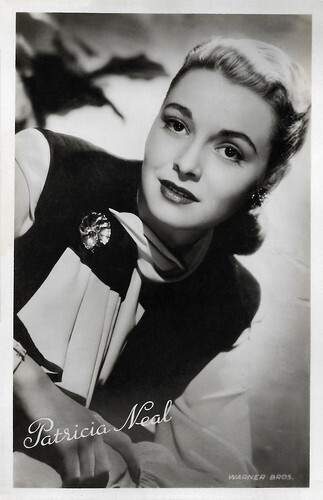
Dutch postcard, no. 3047. Photo: Warner Bros.
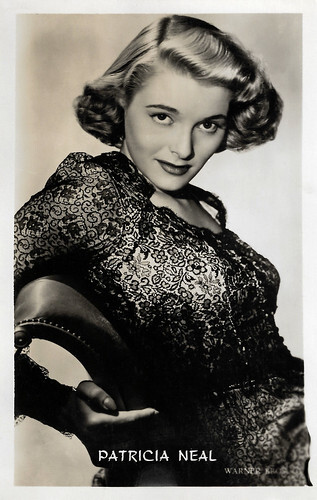
Vintage postcard. Photo: Warner Bros.
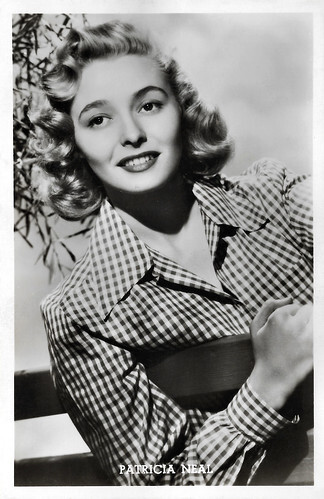
Vintage postcard, no. 86. Photo: Warner Bros.
A hell of a compliment
Patricia Neal was born Patsy Louise Neal in Packard, Kentucky, in 1926. Her father, William Burdette Neal, managed a coal mine and her mother, Eura Mildred Petrey, was the daughter of the town doctor. Patsy grew up, with her two siblings, Pete and Margaret Ann, in Knoxville, Tennessee, where she attended high school.
She was first bit by the acting bug at the age of 10, after attending an evening of monologues at a Methodist church. She subsequently wrote a letter to Santa Claus, telling him, "What I want for Christmas is to study dramatics". She won the Tennessee State Award for dramatic reading while she was in high school. She apprenticed at the Barter Theater in Abingdon, Virginia, when she was 16 years old, between her junior and senior years in high school. After studying drama for two years at Northwestern University, she headed to New York City.
Her first job was as an understudy in the Broadway production of the John Van Druten play 'The Voice of the Turtle' (1947). It was the producer of the play that had her change her name from Patsy Louise to Patricia. After replacing Vivian Vance in the touring company of 'Turtle', she won a role in a play that closed in Boston and then appeared in summer stock.
She won the role of the teenage Regina in Lillian Hellman's play, 'Another Part of the Forest' (1946), a prequel to 'The Little Foxes', for which she won a Tony Award in 1947. According to IMDb, she was visited backstage by Tallulah Bankhead - who had played the middle-aged Regina in the original Broadway production of Hellman's 'The Little Foxes' - and told Neal, "Dahling, you were as good as I was - and if I said you were half as good, it would [still] have been a hell of a compliment!"
The role made the 20-year-old Neal a star. Subsequently, Neal signed a seven-year contract with Warner Bros. In the first part of her film career, her most impressive roles were in The Fountainhead (King Vidor, 1949), opposite the much older Gary Cooper , with whom she had a three-year-long love affair, and in director Robert Wise's Sci-Fi classic, The Day the Earth Stood Still (1951), which she made at 20th Century-Fox. Her affair with the married Cooper led to an abortion and a nervous collapse. It quickened her decision to leave Hollywood.
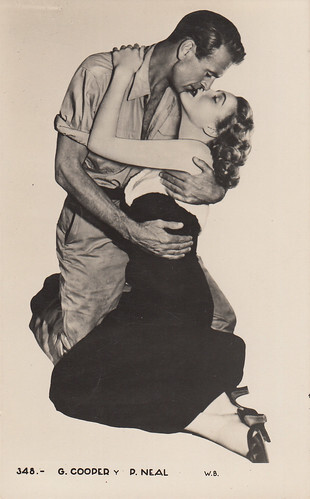
Spanish postcard, no. 348. Photo: Warner Bros. Patricia Neal and Gary Cooper in The Fountainhead (King Vidor, 1949). Collection: Marlene Pilaete.
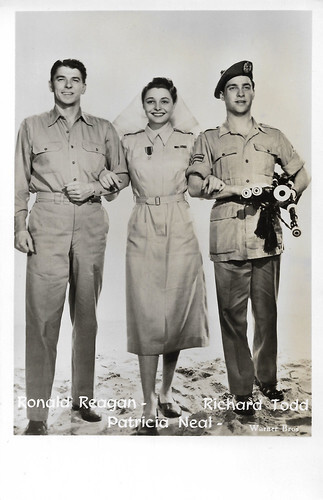
Belgian postcard by Nieuwe Merksemsche Chocolaterie S.P.R.L., Merksem (Anvers), No. D 13. Photo: Warner Bros. Ronald Reagan , Patricia Neal and Richard Todd in The Hasty Heart (Vincent Sherman, 1949).
Suffering a series of strokes
Patricia Neal returned to Broadway and achieved the success that eluded her in films, appearing in the revival of Lillian Hellman's play, 'The Children's Hour', in 1952. She met writer Roald Dahl in 1953 at a formal party, and they were married nine months later. The couple would have five children in 30 years of marriage.
In 1957, Patricia Neal had one of her finest roles in Elia Kazan's parable about the threat of mass-media demagoguery and home-grown fascism in A Face in the Crowd (1957). Before she appeared in the film, Neal had taken over the role of Maggie in Tennessee Williams' 'Cat on a Hot Tin Roof', the Broadway smash that had been directed by Kazan. Returning to the stage, she appeared in the London production of Williams' 'Suddenly, Last Summer' and co-starred with Anne Bancroft in the Broadway production of 'The Miracle Worker'.
After appearing opposite Audrey Hepburn and George Peppard in Breakfast at Tiffany's (Blake Edwards, 1961), she had what was arguably her finest role, as Alma the housekeeper, in Hud (Martin Ritt, 1963) opposite Paul Newman . The film was a hit and Neal won the Best Actress Oscar. She co-starred with John Wayne and Kirk Douglas in the war film In Harm's Way (Otto Preminger, 1965).
In 1965, she suffered a series of strokes. Variety, the entertainment newspaper, mistakenly reported in their 22 February 1965 headline that Patricia Neal had died from her multiple strokes five days earlier. In truth, she remained in a coma for 21 days. She was filming John Ford's film, 7 Women (1965), and had to be replaced by Anne Bancroft. Neal was pregnant at the time. She underwent a seven-hour operation on her brain and survived, later delivering her fifth child. Her daughter, Lucy Dahl, was born healthy, but in its aftermath, the actress suffered from partial paralysis and partial blindness, she lost her memory and was unable to speak.
She underwent rehabilitation supervised by her husband. He designed her strenuous and intense recovery routines, including swimming, walking, memory games and crossword puzzles. Her experiences led to her becoming a champion in the rehabilitation field. She turned down The Graduate (Mike Nichols, 1967) as she had not recovered fully from her stroke. When she returned to the screen, in The Subject Was Roses (Ulu Grosbard, 1968), she suffered from memory problems. According to her director, Ulu Grosbard, "The memory element was the uncertain one. But when we started to shoot, she hit her top level. She really rises to the challenge. She has great range, even more now than before". She received an Oscar nomination for her work. Subsequently, new acting roles equal to her talent were sparse.
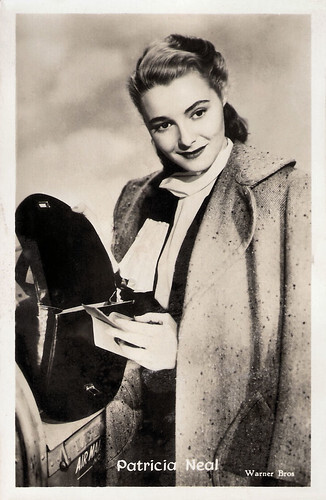
Vintage card. Photo: Warner Bros.
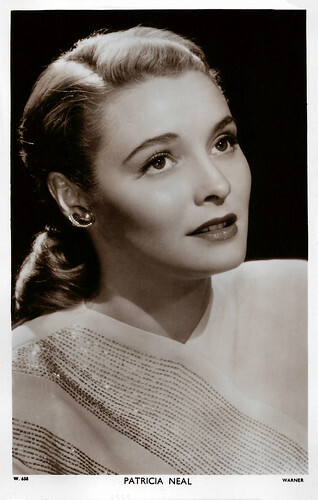
British postcard in the Picturegoer Series, London, no. W 658. Photo: Warner.
Neal and Dahl's ordeal and ultimate victory over her illness
Patricia Neal received three Emmy nominations, the first for originating the role of Olivia Walton in the TV movie The Homecoming: A Christmas Story (Fielder Cook, 1971), which gave birth to the TV show The Waltons (1972). One of her last films was the comedy Cookie's Fortune (Robert Altman, 1999) with Glenn Close and Julianne Moore.
Patricia Neal died in 2010 in Edgarton, Massachusetts from lung cancer. She was 84 years old. She had become a Catholic four months before she died and was buried in the Abbey of Regina Laudis in Bethlehem, Connecticut, where the actress Dolores Hart, her friend since the early 1960s, had become a nun and ultimately prioress.
Neal and Dahl's ordeal and ultimate victory over her illness were told in the television film The Patricia Neal Story (Anthony Harvey, Anthony Page, 1981), starring Glenda Jackson and Dirk Bogarde .
After he played such a strong and devoted role in her physical and mental recovery from her paralytic illness, Neal divorced her husband, Roald Dahl, in 1983 after discovering his long-term affair with her former close friend, Felicity 'Liccy' Crosland. Dahl and Crosland married shortly after his divorce from Neal became final, and remained wed until Dahl's death.
Neal and Dahl had five children: Ophelia Dahl, Lucy Dahl, Theo Dahl, Tessa Dahl, and Olivia Twenty Dahl (1955-1962), who died suddenly from complications of measles encephalitis at the age of seven. The story of Olivia's death and how Neal and Dahl coped with the tragedy was dramatised as a made-for-TV movie, To Olivia (John Hay, 2020). Neal and Dahl had numerous grandchildren. Patricia Neal always refused to reveal the name of her second husband, the man she married after her divorce from Roahl Dahl.
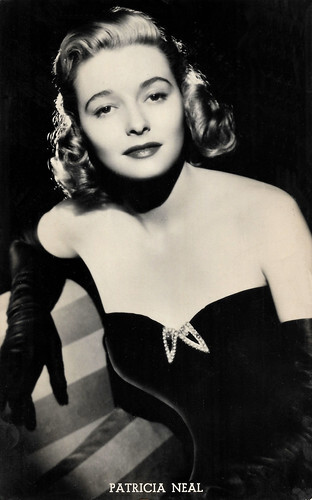
Vintage postcard. Photo: Warner Bros.
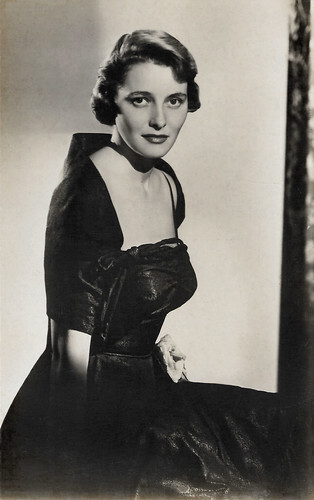
Vintage postcard.
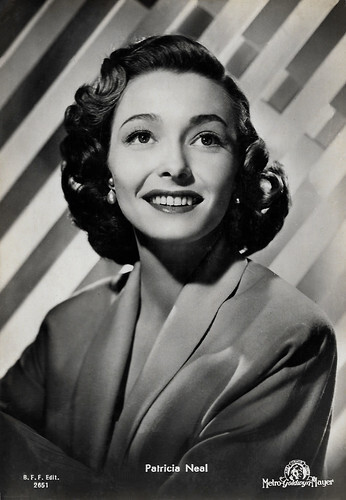
Italian postcard by B.F.F. Edit (Casa Editr. Ballerini & Fratini, Firenze), no. 2651. Photo: Metro-Goldwyn-Mayer.
Sources: (IMDb), Wikipedia (Dutch and English) and .

Dutch postcard, no. 3047. Photo: Warner Bros.

Vintage postcard. Photo: Warner Bros.

Vintage postcard, no. 86. Photo: Warner Bros.
A hell of a compliment
Patricia Neal was born Patsy Louise Neal in Packard, Kentucky, in 1926. Her father, William Burdette Neal, managed a coal mine and her mother, Eura Mildred Petrey, was the daughter of the town doctor. Patsy grew up, with her two siblings, Pete and Margaret Ann, in Knoxville, Tennessee, where she attended high school.
She was first bit by the acting bug at the age of 10, after attending an evening of monologues at a Methodist church. She subsequently wrote a letter to Santa Claus, telling him, "What I want for Christmas is to study dramatics". She won the Tennessee State Award for dramatic reading while she was in high school. She apprenticed at the Barter Theater in Abingdon, Virginia, when she was 16 years old, between her junior and senior years in high school. After studying drama for two years at Northwestern University, she headed to New York City.
Her first job was as an understudy in the Broadway production of the John Van Druten play 'The Voice of the Turtle' (1947). It was the producer of the play that had her change her name from Patsy Louise to Patricia. After replacing Vivian Vance in the touring company of 'Turtle', she won a role in a play that closed in Boston and then appeared in summer stock.
She won the role of the teenage Regina in Lillian Hellman's play, 'Another Part of the Forest' (1946), a prequel to 'The Little Foxes', for which she won a Tony Award in 1947. According to IMDb, she was visited backstage by Tallulah Bankhead - who had played the middle-aged Regina in the original Broadway production of Hellman's 'The Little Foxes' - and told Neal, "Dahling, you were as good as I was - and if I said you were half as good, it would [still] have been a hell of a compliment!"
The role made the 20-year-old Neal a star. Subsequently, Neal signed a seven-year contract with Warner Bros. In the first part of her film career, her most impressive roles were in The Fountainhead (King Vidor, 1949), opposite the much older Gary Cooper , with whom she had a three-year-long love affair, and in director Robert Wise's Sci-Fi classic, The Day the Earth Stood Still (1951), which she made at 20th Century-Fox. Her affair with the married Cooper led to an abortion and a nervous collapse. It quickened her decision to leave Hollywood.

Spanish postcard, no. 348. Photo: Warner Bros. Patricia Neal and Gary Cooper in The Fountainhead (King Vidor, 1949). Collection: Marlene Pilaete.

Belgian postcard by Nieuwe Merksemsche Chocolaterie S.P.R.L., Merksem (Anvers), No. D 13. Photo: Warner Bros. Ronald Reagan , Patricia Neal and Richard Todd in The Hasty Heart (Vincent Sherman, 1949).
Suffering a series of strokes
Patricia Neal returned to Broadway and achieved the success that eluded her in films, appearing in the revival of Lillian Hellman's play, 'The Children's Hour', in 1952. She met writer Roald Dahl in 1953 at a formal party, and they were married nine months later. The couple would have five children in 30 years of marriage.
In 1957, Patricia Neal had one of her finest roles in Elia Kazan's parable about the threat of mass-media demagoguery and home-grown fascism in A Face in the Crowd (1957). Before she appeared in the film, Neal had taken over the role of Maggie in Tennessee Williams' 'Cat on a Hot Tin Roof', the Broadway smash that had been directed by Kazan. Returning to the stage, she appeared in the London production of Williams' 'Suddenly, Last Summer' and co-starred with Anne Bancroft in the Broadway production of 'The Miracle Worker'.
After appearing opposite Audrey Hepburn and George Peppard in Breakfast at Tiffany's (Blake Edwards, 1961), she had what was arguably her finest role, as Alma the housekeeper, in Hud (Martin Ritt, 1963) opposite Paul Newman . The film was a hit and Neal won the Best Actress Oscar. She co-starred with John Wayne and Kirk Douglas in the war film In Harm's Way (Otto Preminger, 1965).
In 1965, she suffered a series of strokes. Variety, the entertainment newspaper, mistakenly reported in their 22 February 1965 headline that Patricia Neal had died from her multiple strokes five days earlier. In truth, she remained in a coma for 21 days. She was filming John Ford's film, 7 Women (1965), and had to be replaced by Anne Bancroft. Neal was pregnant at the time. She underwent a seven-hour operation on her brain and survived, later delivering her fifth child. Her daughter, Lucy Dahl, was born healthy, but in its aftermath, the actress suffered from partial paralysis and partial blindness, she lost her memory and was unable to speak.
She underwent rehabilitation supervised by her husband. He designed her strenuous and intense recovery routines, including swimming, walking, memory games and crossword puzzles. Her experiences led to her becoming a champion in the rehabilitation field. She turned down The Graduate (Mike Nichols, 1967) as she had not recovered fully from her stroke. When she returned to the screen, in The Subject Was Roses (Ulu Grosbard, 1968), she suffered from memory problems. According to her director, Ulu Grosbard, "The memory element was the uncertain one. But when we started to shoot, she hit her top level. She really rises to the challenge. She has great range, even more now than before". She received an Oscar nomination for her work. Subsequently, new acting roles equal to her talent were sparse.

Vintage card. Photo: Warner Bros.

British postcard in the Picturegoer Series, London, no. W 658. Photo: Warner.
Neal and Dahl's ordeal and ultimate victory over her illness
Patricia Neal received three Emmy nominations, the first for originating the role of Olivia Walton in the TV movie The Homecoming: A Christmas Story (Fielder Cook, 1971), which gave birth to the TV show The Waltons (1972). One of her last films was the comedy Cookie's Fortune (Robert Altman, 1999) with Glenn Close and Julianne Moore.
Patricia Neal died in 2010 in Edgarton, Massachusetts from lung cancer. She was 84 years old. She had become a Catholic four months before she died and was buried in the Abbey of Regina Laudis in Bethlehem, Connecticut, where the actress Dolores Hart, her friend since the early 1960s, had become a nun and ultimately prioress.
Neal and Dahl's ordeal and ultimate victory over her illness were told in the television film The Patricia Neal Story (Anthony Harvey, Anthony Page, 1981), starring Glenda Jackson and Dirk Bogarde .
After he played such a strong and devoted role in her physical and mental recovery from her paralytic illness, Neal divorced her husband, Roald Dahl, in 1983 after discovering his long-term affair with her former close friend, Felicity 'Liccy' Crosland. Dahl and Crosland married shortly after his divorce from Neal became final, and remained wed until Dahl's death.
Neal and Dahl had five children: Ophelia Dahl, Lucy Dahl, Theo Dahl, Tessa Dahl, and Olivia Twenty Dahl (1955-1962), who died suddenly from complications of measles encephalitis at the age of seven. The story of Olivia's death and how Neal and Dahl coped with the tragedy was dramatised as a made-for-TV movie, To Olivia (John Hay, 2020). Neal and Dahl had numerous grandchildren. Patricia Neal always refused to reveal the name of her second husband, the man she married after her divorce from Roahl Dahl.

Vintage postcard. Photo: Warner Bros.

Vintage postcard.

Italian postcard by B.F.F. Edit (Casa Editr. Ballerini & Fratini, Firenze), no. 2651. Photo: Metro-Goldwyn-Mayer.
Sources: (IMDb), Wikipedia (Dutch and English) and .
Published on October 26, 2023 22:00
October 25, 2023
Rory Calhoun
Tall and handsome Rory Calhoun (1922-1999) was an American film and TV actor who also worked as a screenwriter, producer and author. He appeared in more than 80 films and more than a thousand episodes of various TV shows. His films include How to Marry a Millionaire (1953), River of No Return (1954) and The Spoilers (1955).

Italian postcard by Bromofoto, Milano. Photo: Universal International.
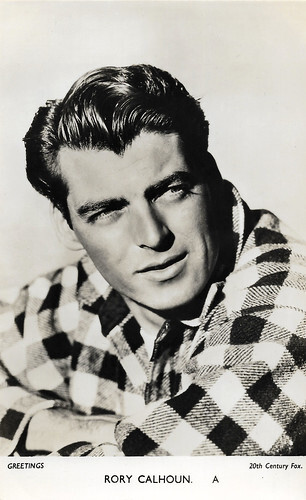
British postcard in the Greetings series, no. A.Photo: 20th Century Fox.
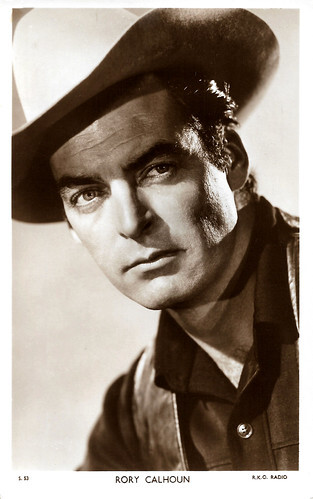
British postcard in the Picturegoer Series, London, no. S.53. Photo: R.K.O. Radio.
His young criminal career was rather extensive
Rory Calhoun was born Francis Timothy McCown in 1922 in Los Angeles, California. His father was James 'Floyd' McCown, a professional gambler, and his mother was Elizabeth Cuthbert. When he was nine months old his father died. After his mother remarried he occasionally used the last name of his stepfather, Durgin.
His young criminal career was rather extensive. A high school dropout, he stole a revolver at age 13, which landed him in the California Youth Authority's Preston School of Industry reformatory at Ione, CA. He escaped while in the adjustment centre (jail within the jail). He left home at 17 to escape beatings from his stepfather and began hot-wiring cars. After robbing several jewellery stores, he stole a car and drove it across state lines. This offence sent him to the federal penitentiary in Springfield, MO, for three years. When he finished his sentence he was incarcerated in San Quentin State Penitentiary in California on other charges and remained there until he was paroled just before his 21st birthday. Before becoming an actor he worked as a boxer, a lumberjack, a truck driver and a cowpuncher.
His life changed when a Hollywood agent, Sue Carol, auditioned him at 20th Century Fox. He was noticed by Alan Ladd , Sue's husband when Rory was riding a horse in a Los Angeles park. Impressed with Calhoun's physique, Ladd introduced him to Sue. Rory got a bit role in Something for the Boys (Lewis Seiler, 1944), with Carmen Miranda . He got his first credited role as Frank McCown in the Laurel and Hardy comedy, The Bullfighters (Malcolm St. Clair, 1945). He was signed to a contract by Henry Wilson, an agent known for a stable of young and attractive actors with unusual names like Rock Hudson and Tab Hunter . He initially christened him "Troy Donahue", then changed it to "Rory Calhoun". Wilson used the Troy Donahue name later on another up-and-coming actor. Wilson was an employee of David O. Selznick and he signed Calhoun in Selznick's company.
His first public appearance was as Lana Turner 's escort to the premiere of Alfred Hitchcock 's Spellbound (1945), a Selznick production. The glamorous blonde and her handsome companion attracted the paparazzi, and photos appeared in newspapers and fan magazines. In 1945, he was sent again to prison for beating a detective. Calhoun did not appear in a film for a year before being lent to producer Sol Lesser for the thriller The Red House (Delmer Daves, 1947) with Edward G. Robinson . In the same year, he worked in two more films, Adventure Island (Sam Newfield, 1947) and That Hagen Girl (Peter Godfrey, 1947) starring Shirley Temple . He graduated to starring in Westerns such as Sand (Louis King, 1949). He first appeared in a negative role in Return of Frontiersman (Richard L. Bare, 1950), starring Gordon MacRae and Julie London.
In August 1950, Rory Calhoun signed a seven-year contract with 20th Century Fox. Some of his first films for Fox were such Westerns as A Ticket to Tomahawk (Richard Sale, 1950), and Rogue River (John Rawlins, 1951). With Susan Hayward , he co-starred in the musical With a Song in My Heart (Walter Lang, 1952) and with Gene Tierney in the Western Way of a Gaucho (Jacques Tourneur, 1952). Calhoun co-starred with Marilyn Monroe in the comedy How to Marry a Millionaire (Jean Negulesco, 1953) as Betty Grable's love interest and the Western River of No Return (Otto Preminger, Jean Negulesco, 1954), starring Robert Mitchum . Both films were big hits. Calhoun then left Fox. He starred in such Westerns as The Yellow Tomahawk (Lesley Selander, 1954), A Bullet is Waiting (John Farrow, 1954) and The Spoilers (Jesse Hibbs, 1955) with Ann Baxter.
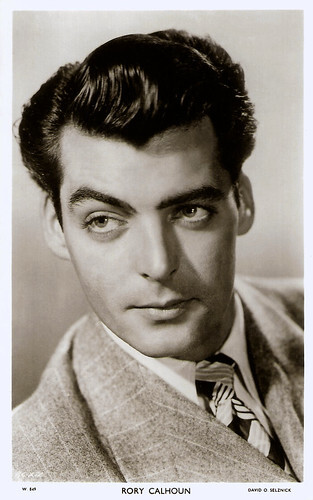
British postcard in the Filmgoer Series, London, no. W 849. Photo: David O. Selznick.
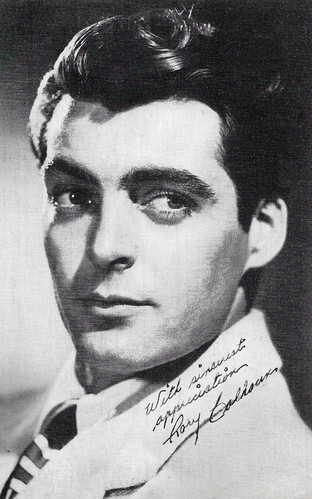
American postcard by Vanguard Studio, Culver City, California, sent by mail in 1949.
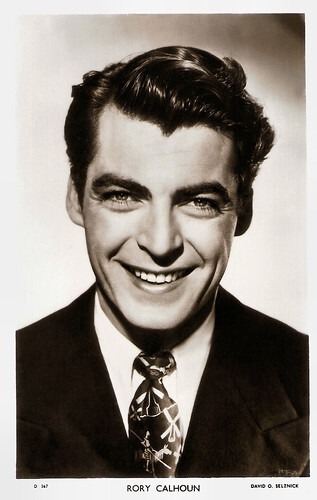
British postcard in the Picturegoer Series, London, no. D 567. Photo: David O. Selznick.
His mugshot on the cover of Confidential magazine
Rory Calhoun's conviction history became public when his mugshot appeared on the May 1955 cover of Confidential magazine. According to one source, his agent, Henry Willson, disclosed information about Calhoun's years in prison to Confidential in exchange for the tabloid not printing an exposé about the secret homosexual life of Rock Hudson , another Willson client. According to another source, blackmailers threatened to make his prison record public, so instead, Calhoun revealed it himself. However, the disclosure had no negative effect on Calhoun's career and only served to solidify his 'bad boy' image.
He starred in such Westerns as Raw Edge (John Sherwood, 1956), The Hired Gun (Ray Nazzaro, 1957) and Ride Out of Revenge (1958). In 1957, Rory and his partner Victor Orsatti started a film production company called 'Rorvic'. He helped produce films like the Film Noir Flight to Hong Kong (Joseph M. Newman, 1956), and the Westerns The Hired Gun (Ray Nazzaro, 1957), Domino Kid (Ray Nazzaro, 1957), and Apache Territory (Ray Nazzaro, 1958). In 1959, he made his television debut in The Texan (1959-1960). Around this time, Rory also started scriptwriting. He also appeared in an episode of the CBS show December Bride (1959). The episode was called 'Rory Calhoun the Texan'.
In the early 1960s, Rory Calhoun starred in the stock car racing film Thunder in Carolina (Paul Helmick, 1960), and the Peplum Il Colosso di Rodi/The Colossus of Rhodes (1961), co-written and directed by Sergio Leone. The film was Leone's first work as a credited director, in a genre where he already had worked before as the replacement director for The Last Days of Pompeii and as a secondary director for both Ben-Hur and Quo Vadis. The film was originally meant to star John Derek. However, he clashed with Sergio Leone and was replaced by Rory Calhoun. Calhoun travelled to Spain to make the film, then to Great Britain for The Treasure of Monte Cristo (Monty Berman, Robert S. Baker, 1961) in Britain, and then to Italy for L'avventura di un italiano in Cina/Marco Polo (Piero Pierotti, 1962) with Yoko Tani. He returned to the U.S. to make several films for producer A.C. Lyles, such as the war film The Young and the Brave (Francis D. Lyon, 1963) and the Western Apache Rising (R.G. Springsteen, 1965), with Corinne Calvet .
He returned to Europe to make the French Eurospy film Our Men in Bagdad (Paolo Bianchini, 1966) with Roger Hanin , and the Spanish adventure film The Emerald of Artatama (José María Elorrieta, 1969). During the 1960s, he also guest-starred in several popular TV shows like Death Valley Days (1963), Bonanza (1964), Gunsmoke (1965), I Spy (1966), Gilligan's Island (1967) and Custer (1969). In the 1970s he could be seen in TV shows such as The Doris Day Show (1972), Police Story (1973), Starsky and Hutch (1975) and Fantasy Land (1978). In 1982, he appeared for five years as Judge Judson Tyler on the US soap opera Capitol and remained on the show until it ended in 1987. In the cinema, he starred in cult films like the Science-Fiction horror film Night of the Lepus (William F. Claxton, 1972) with Janet Leigh , the comedy horror film Motel Hell (Kevin Connor, 1980), the exploitation horror film Angel (Robert Vincent O'Neill, 1984), and the Science-Fiction action film Hell Comes to Frogtown (Donald G. Jackson, R. J. Kizer, 1989). He produced himself Fists of Steel (Jerry Schafer, 1991). His last film as an actor was Pure Country (Christopher Cain, 1992) in which the still handsome Calhoun played the character of 'Earnest Tucker', a family patriarch and farmer. His last screen appearance was in the horror anthology television series Tales from the Crypt (1993).
Rory Calhoun was married three times, once to his first wife and twice to his second wife. His first wife was Lita Baron (1948-1970), with whom he had three daughters, Cindy (1957), Tami (1958) and Lorri (1961). At the time of the divorce, Baron accused him of committing adultery with more than 70 women, including Betty Grable . Reportedly, Calhoun responded, "Heck, she didn't even include half of them". His second wife was journalist Sue Rhodes (1971-1979; 1982-1999) with whom he had one daughter, Rory Patricia (1971). He also had a daughter with actress Vitina Marcus, Athena Marcus Calhoun, who became "The World's Most Beautiful Showgirl" and was awarded "The Key to the City of Las Vegas" in 1987. Guy Madison was one of his closest friends. The two men often went on fishing and hunting trips. Guy and his (second) wife Sheila Connolly named him godfather to their firstborn Bridget. Rory Calhoun passed away in 1999 at the age of 76 after a ten-day hospitalisation at Providence Saint Joseph Medical Center in Burbank, California. He died due to complications from emphysema and diabetes. Calhoun has two stars on Hollywood's Walk of Fame: one for motion pictures, and one for television.
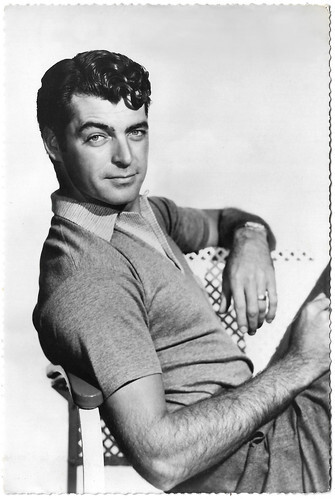
Yugoslavian postcard by ZK, no. 3925.
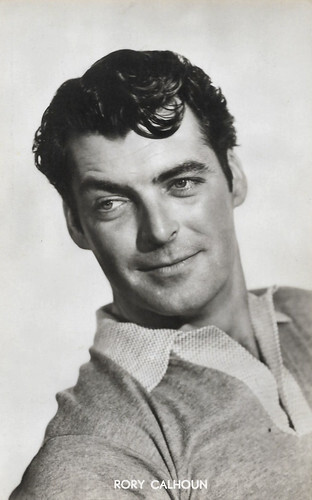
Vintage postcard.
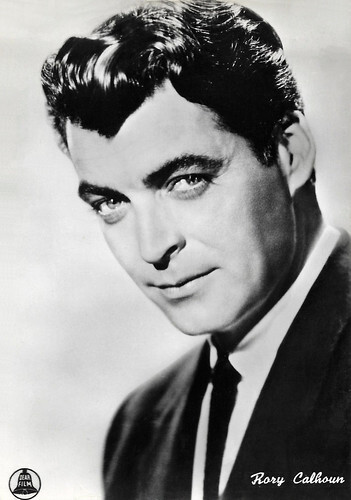
Italian postcard by Bromofoto, Milano, no. 1881. Photo: Dear Film.
Sources: (IMDb), Celeb-true (Dutch), Wikipedia and .

Italian postcard by Bromofoto, Milano. Photo: Universal International.

British postcard in the Greetings series, no. A.Photo: 20th Century Fox.

British postcard in the Picturegoer Series, London, no. S.53. Photo: R.K.O. Radio.
His young criminal career was rather extensive
Rory Calhoun was born Francis Timothy McCown in 1922 in Los Angeles, California. His father was James 'Floyd' McCown, a professional gambler, and his mother was Elizabeth Cuthbert. When he was nine months old his father died. After his mother remarried he occasionally used the last name of his stepfather, Durgin.
His young criminal career was rather extensive. A high school dropout, he stole a revolver at age 13, which landed him in the California Youth Authority's Preston School of Industry reformatory at Ione, CA. He escaped while in the adjustment centre (jail within the jail). He left home at 17 to escape beatings from his stepfather and began hot-wiring cars. After robbing several jewellery stores, he stole a car and drove it across state lines. This offence sent him to the federal penitentiary in Springfield, MO, for three years. When he finished his sentence he was incarcerated in San Quentin State Penitentiary in California on other charges and remained there until he was paroled just before his 21st birthday. Before becoming an actor he worked as a boxer, a lumberjack, a truck driver and a cowpuncher.
His life changed when a Hollywood agent, Sue Carol, auditioned him at 20th Century Fox. He was noticed by Alan Ladd , Sue's husband when Rory was riding a horse in a Los Angeles park. Impressed with Calhoun's physique, Ladd introduced him to Sue. Rory got a bit role in Something for the Boys (Lewis Seiler, 1944), with Carmen Miranda . He got his first credited role as Frank McCown in the Laurel and Hardy comedy, The Bullfighters (Malcolm St. Clair, 1945). He was signed to a contract by Henry Wilson, an agent known for a stable of young and attractive actors with unusual names like Rock Hudson and Tab Hunter . He initially christened him "Troy Donahue", then changed it to "Rory Calhoun". Wilson used the Troy Donahue name later on another up-and-coming actor. Wilson was an employee of David O. Selznick and he signed Calhoun in Selznick's company.
His first public appearance was as Lana Turner 's escort to the premiere of Alfred Hitchcock 's Spellbound (1945), a Selznick production. The glamorous blonde and her handsome companion attracted the paparazzi, and photos appeared in newspapers and fan magazines. In 1945, he was sent again to prison for beating a detective. Calhoun did not appear in a film for a year before being lent to producer Sol Lesser for the thriller The Red House (Delmer Daves, 1947) with Edward G. Robinson . In the same year, he worked in two more films, Adventure Island (Sam Newfield, 1947) and That Hagen Girl (Peter Godfrey, 1947) starring Shirley Temple . He graduated to starring in Westerns such as Sand (Louis King, 1949). He first appeared in a negative role in Return of Frontiersman (Richard L. Bare, 1950), starring Gordon MacRae and Julie London.
In August 1950, Rory Calhoun signed a seven-year contract with 20th Century Fox. Some of his first films for Fox were such Westerns as A Ticket to Tomahawk (Richard Sale, 1950), and Rogue River (John Rawlins, 1951). With Susan Hayward , he co-starred in the musical With a Song in My Heart (Walter Lang, 1952) and with Gene Tierney in the Western Way of a Gaucho (Jacques Tourneur, 1952). Calhoun co-starred with Marilyn Monroe in the comedy How to Marry a Millionaire (Jean Negulesco, 1953) as Betty Grable's love interest and the Western River of No Return (Otto Preminger, Jean Negulesco, 1954), starring Robert Mitchum . Both films were big hits. Calhoun then left Fox. He starred in such Westerns as The Yellow Tomahawk (Lesley Selander, 1954), A Bullet is Waiting (John Farrow, 1954) and The Spoilers (Jesse Hibbs, 1955) with Ann Baxter.

British postcard in the Filmgoer Series, London, no. W 849. Photo: David O. Selznick.

American postcard by Vanguard Studio, Culver City, California, sent by mail in 1949.

British postcard in the Picturegoer Series, London, no. D 567. Photo: David O. Selznick.
His mugshot on the cover of Confidential magazine
Rory Calhoun's conviction history became public when his mugshot appeared on the May 1955 cover of Confidential magazine. According to one source, his agent, Henry Willson, disclosed information about Calhoun's years in prison to Confidential in exchange for the tabloid not printing an exposé about the secret homosexual life of Rock Hudson , another Willson client. According to another source, blackmailers threatened to make his prison record public, so instead, Calhoun revealed it himself. However, the disclosure had no negative effect on Calhoun's career and only served to solidify his 'bad boy' image.
He starred in such Westerns as Raw Edge (John Sherwood, 1956), The Hired Gun (Ray Nazzaro, 1957) and Ride Out of Revenge (1958). In 1957, Rory and his partner Victor Orsatti started a film production company called 'Rorvic'. He helped produce films like the Film Noir Flight to Hong Kong (Joseph M. Newman, 1956), and the Westerns The Hired Gun (Ray Nazzaro, 1957), Domino Kid (Ray Nazzaro, 1957), and Apache Territory (Ray Nazzaro, 1958). In 1959, he made his television debut in The Texan (1959-1960). Around this time, Rory also started scriptwriting. He also appeared in an episode of the CBS show December Bride (1959). The episode was called 'Rory Calhoun the Texan'.
In the early 1960s, Rory Calhoun starred in the stock car racing film Thunder in Carolina (Paul Helmick, 1960), and the Peplum Il Colosso di Rodi/The Colossus of Rhodes (1961), co-written and directed by Sergio Leone. The film was Leone's first work as a credited director, in a genre where he already had worked before as the replacement director for The Last Days of Pompeii and as a secondary director for both Ben-Hur and Quo Vadis. The film was originally meant to star John Derek. However, he clashed with Sergio Leone and was replaced by Rory Calhoun. Calhoun travelled to Spain to make the film, then to Great Britain for The Treasure of Monte Cristo (Monty Berman, Robert S. Baker, 1961) in Britain, and then to Italy for L'avventura di un italiano in Cina/Marco Polo (Piero Pierotti, 1962) with Yoko Tani. He returned to the U.S. to make several films for producer A.C. Lyles, such as the war film The Young and the Brave (Francis D. Lyon, 1963) and the Western Apache Rising (R.G. Springsteen, 1965), with Corinne Calvet .
He returned to Europe to make the French Eurospy film Our Men in Bagdad (Paolo Bianchini, 1966) with Roger Hanin , and the Spanish adventure film The Emerald of Artatama (José María Elorrieta, 1969). During the 1960s, he also guest-starred in several popular TV shows like Death Valley Days (1963), Bonanza (1964), Gunsmoke (1965), I Spy (1966), Gilligan's Island (1967) and Custer (1969). In the 1970s he could be seen in TV shows such as The Doris Day Show (1972), Police Story (1973), Starsky and Hutch (1975) and Fantasy Land (1978). In 1982, he appeared for five years as Judge Judson Tyler on the US soap opera Capitol and remained on the show until it ended in 1987. In the cinema, he starred in cult films like the Science-Fiction horror film Night of the Lepus (William F. Claxton, 1972) with Janet Leigh , the comedy horror film Motel Hell (Kevin Connor, 1980), the exploitation horror film Angel (Robert Vincent O'Neill, 1984), and the Science-Fiction action film Hell Comes to Frogtown (Donald G. Jackson, R. J. Kizer, 1989). He produced himself Fists of Steel (Jerry Schafer, 1991). His last film as an actor was Pure Country (Christopher Cain, 1992) in which the still handsome Calhoun played the character of 'Earnest Tucker', a family patriarch and farmer. His last screen appearance was in the horror anthology television series Tales from the Crypt (1993).
Rory Calhoun was married three times, once to his first wife and twice to his second wife. His first wife was Lita Baron (1948-1970), with whom he had three daughters, Cindy (1957), Tami (1958) and Lorri (1961). At the time of the divorce, Baron accused him of committing adultery with more than 70 women, including Betty Grable . Reportedly, Calhoun responded, "Heck, she didn't even include half of them". His second wife was journalist Sue Rhodes (1971-1979; 1982-1999) with whom he had one daughter, Rory Patricia (1971). He also had a daughter with actress Vitina Marcus, Athena Marcus Calhoun, who became "The World's Most Beautiful Showgirl" and was awarded "The Key to the City of Las Vegas" in 1987. Guy Madison was one of his closest friends. The two men often went on fishing and hunting trips. Guy and his (second) wife Sheila Connolly named him godfather to their firstborn Bridget. Rory Calhoun passed away in 1999 at the age of 76 after a ten-day hospitalisation at Providence Saint Joseph Medical Center in Burbank, California. He died due to complications from emphysema and diabetes. Calhoun has two stars on Hollywood's Walk of Fame: one for motion pictures, and one for television.

Yugoslavian postcard by ZK, no. 3925.

Vintage postcard.

Italian postcard by Bromofoto, Milano, no. 1881. Photo: Dear Film.
Sources: (IMDb), Celeb-true (Dutch), Wikipedia and .
Published on October 25, 2023 22:00
October 24, 2023
Romeo and Juliet (1968)
Romeo e Giulietta/Romeo and Juliet (Franco Zeffirelli, 1968) is the most financially successful film adaptation of a Shakespeare play at the time of its release. By writing the play, Shakespeare began the shaping of modern drama, in which the fates of ordinary people are as crucial as those of the great. The film features the very young and unknown Leonard Whiting and Olivia Hussey as the star-crossed lovers. Laurence Olivier spoke the film's prologue and epilogue and dubbed the voice of Antonio Pierfederici, who played Lord Montague but was not credited on-screen. The film also stars Milo O'Shea as Friar Laurence, Michael York as Tybalt, John McEnery as Mercutio, Bruce Robinson as Benvolio, and Robert Stephens as The Prince of Verona. The film was popular among teenagers partly because it was the first film to use actors who were close to the age of the characters from the original play. Romeo e Giulietta/Romeo and Juliet won Oscars for Best Cinematography (Pasqualino De Santis) and Best Costume Design (Danilo Donati). Its most lasting legacy is its popular main theme music, composed by Nino Rota, who wrote the music for most of Federico Fellini's films.
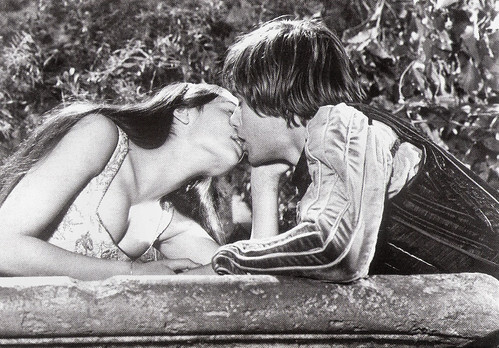
West German postcard by Palast. Photo: picture-alliance / KPA. Leonard Whiting and Olivia Hussey in Romeo and Juliet (Franco Zeffirelli, 1968).
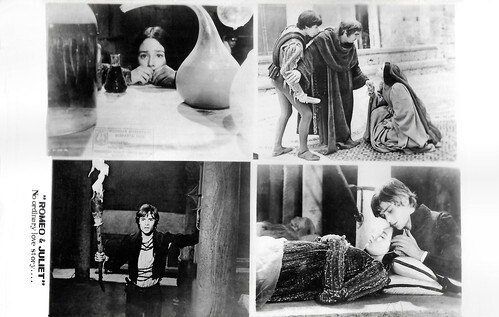
Vintage card. Olivia Hussey and Leonard Whiting in Romeo and Juliet (Franco Zeffirelli, 1968). Caption: No ordinary love story....
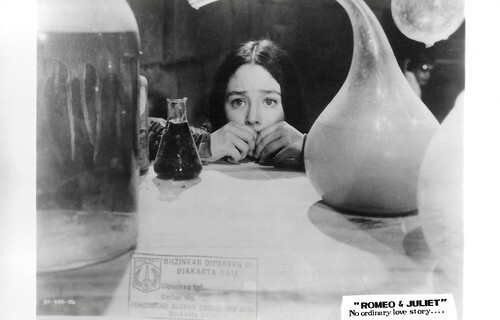
Indonesian postcard. Olivia Hussey in Romeo and Juliet (Franco Zeffirelli, 1968). Caption: No ordinary love story....
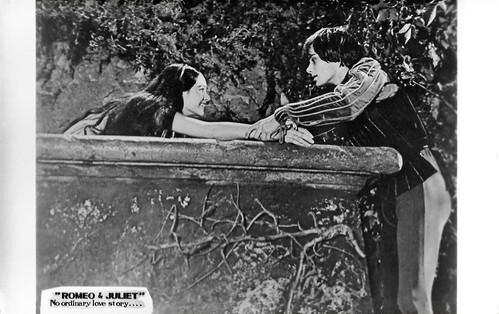
Vintage card. Olivia Hussey and Leonard Whiting in Romeo and Juliet (Franco Zeffirelli, 1968). Caption: No ordinary love story....
A Forbidden Romance in Verona
Romeo and Juliet is set in 14th-century Renaissance Italy. One summer morning in Verona, a longstanding feud between the Montague and the Capulet clans breaks out in a street brawl. The brawl is broken up by the Prince, who warns both families that any future violence between them will result in harsh consequences. That night, two teenagers of the two families—Romeo and Juliet—meet at a Capulet masked ball and fall in love. Later, Romeo stumbles into the secluded garden under Juliet's bedroom balcony and the two exchange impassioned pledges. They are secretly married the next day by Romeo's confessor and father figure, Friar Laurence, with the assistance of Juliet's nurse.
That afternoon, Juliet's cousin Tybalt, furious that Romeo had attended his family's ball, insults him and challenges him to a brawl. Romeo now regards Tybalt as family and he refuses to fight him, which leads Romeo's best friend, Mercutio, to fight Tybalt instead. Despite Romeo's efforts to stop the fight, Tybalt mortally wounds Mercutio, who curses both the Montague and Capulet houses before dying. Enraged over his friend's death, Romeo retaliates by fighting Tybalt and killing him. Romeo is subsequently punished by the Prince with banishment from Verona, with the threat of death if he ever returns. Romeo then secretly spends his wedding night with Juliet, the couple consummate their marriage, and Romeo flees. Juliet's parents, unaware of their daughter's secret marriage, have arranged for Juliet to marry wealthy Count Paris. Juliet pleads with her parents to postpone the marriage, but they refuse and threaten to disown her. Juliet seeks out Friar Laurence for help, hoping to escape her arranged marriage to Paris and remain faithful to Romeo. At Friar Laurence's behest, she reconciles with her parents and agrees to their wishes.
On the night before the wedding, Juliet consumes a potion prepared by Friar Laurence intended to make her appear dead for 42 hours. Friar Laurence plans to inform Romeo of the hoax so that Romeo can meet Juliet after her burial and escape with her when she recovers from her swoon, so he sends Friar John to give Romeo a letter describing the plan. However, when Balthasar, Romeo's servant, sees Juliet being buried under the impression that she is dead, he goes to tell Romeo and reaches him before Friar John. In despair, Romeo goes to Juliet's tomb and kills himself by drinking poison. Soon afterwards, Friar Laurence arrives as Juliet awakens. Despite his attempts to persuade her to flee from the crypt, Juliet refuses to leave Romeo, and once the Friar flees, she kills herself by plunging his dagger into her chest. Later, the two families, having ended their feud, attend their joint funeral and are condemned by the Prince.
Romeo and Juliet has been filmed many times in many ways. In 1967, Franco Zeffirelli engaged in a worldwide search for unknown teenage actors to play the parts of the two lovers. Anjelica Huston was in the running for Juliet, but her father, the director John Huston, withdrew her from consideration when he decided to cast her in his film A Walk with Love and Death. Leonard Whiting was 16 and Olivia Hussey was 15 during casting, but were 17 and 16 when filming began in the summer of 1967. Zeffirelli adapted the play in such a way as to play to their strengths and hide their weaknesses: for instance, long speeches were trimmed, and he emphasized reaction shots. Romeo e Giulietta/Romeo and Juliet (Franco Zeffirelli, 1968) was nominated for the Academy Award Best Director and Best Picture. It was the last Shakespearean film to date to be nominated for the latter category. Leonard Whiting and Olivia Hussey both won Golden Globe Awards for Most Promising Newcomers.
Roger Ebert of the Chicago Sun-Times wrote about the film: "I believe Franco Zeffirelli's Romeo and Juliet is the most exciting film of Shakespeare ever made." Dan Jardine at AllMovie: "The unrepentant romanticism of Franco Zeffirelli's Romeo and Juliet works beautifully in translating William Shakespeare's tragic drama to the silver screen. The lyrical score of Academy Award-winner Nino Rota (The Godfather) and the voluptuous and magnificent period costumes by Danilo Donati combine with the sensuous and dusty cinematography of Pasqualino De Santis to evoke the Italian Renaissance setting perfectly. Ever the traditionalist, Zefferelli took a consistently conventional approach to the production, with his only really daring move coming in the casting. For the first time in film, two teenage actors portray Shakespeare's tragic protagonists, and the employment of a cast rife with unknowns results in the film being a triumph of spirit and enthusiasm over technique."
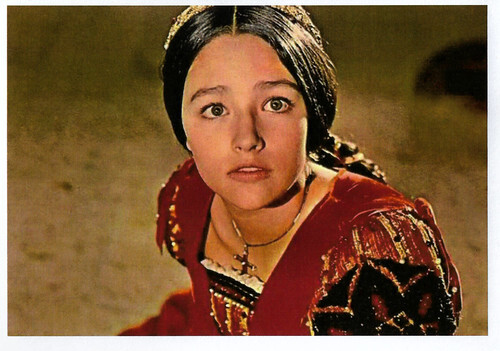
Italian postcard. Olivia Hussey in Romeo and Juliet (Franco Zeffirelli, 1968).
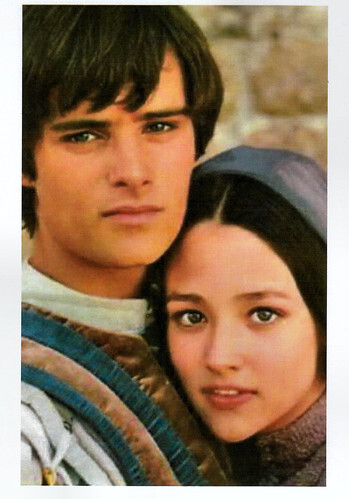
Italian postcard. Leonard Whiting and Olivia Hussey in Romeo and Juliet (Franco Zeffirelli, 1968).
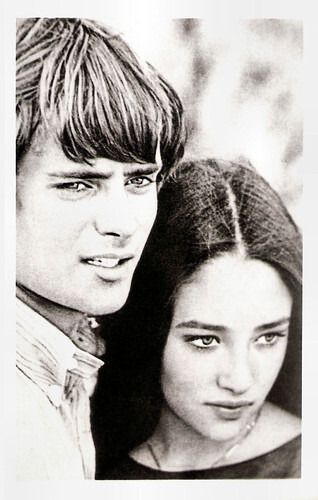
Vintage card, sent by mail in 1976. Leonard Whiting and Olivia Hussey.
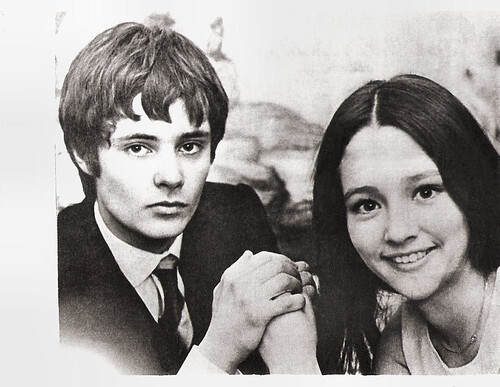
Vintage card. Olivia Hussey and Leonard Whiting.
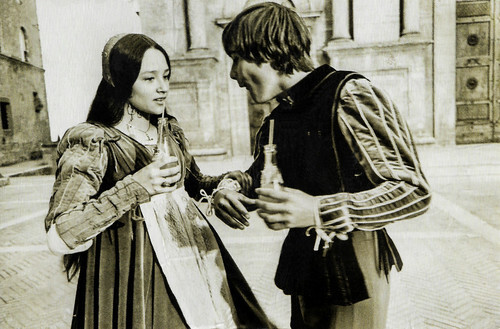
Italian promocard by Palazzo Piccolomini, Pienza, 2018. This card was published to promote the celebrations for the 50th anniversary of the release of Romeo and Juliet (Franco Zeffirelli, 1968) starring Olivia Hussey and Leonard Whiting.
Sources: Roger Ebert (Roger Ebert.com), Hal Erickson (AllMovie), Dan Jardine (AllMovie), Wikipedia and IMDb.

West German postcard by Palast. Photo: picture-alliance / KPA. Leonard Whiting and Olivia Hussey in Romeo and Juliet (Franco Zeffirelli, 1968).

Vintage card. Olivia Hussey and Leonard Whiting in Romeo and Juliet (Franco Zeffirelli, 1968). Caption: No ordinary love story....

Indonesian postcard. Olivia Hussey in Romeo and Juliet (Franco Zeffirelli, 1968). Caption: No ordinary love story....

Vintage card. Olivia Hussey and Leonard Whiting in Romeo and Juliet (Franco Zeffirelli, 1968). Caption: No ordinary love story....
A Forbidden Romance in Verona
Romeo and Juliet is set in 14th-century Renaissance Italy. One summer morning in Verona, a longstanding feud between the Montague and the Capulet clans breaks out in a street brawl. The brawl is broken up by the Prince, who warns both families that any future violence between them will result in harsh consequences. That night, two teenagers of the two families—Romeo and Juliet—meet at a Capulet masked ball and fall in love. Later, Romeo stumbles into the secluded garden under Juliet's bedroom balcony and the two exchange impassioned pledges. They are secretly married the next day by Romeo's confessor and father figure, Friar Laurence, with the assistance of Juliet's nurse.
That afternoon, Juliet's cousin Tybalt, furious that Romeo had attended his family's ball, insults him and challenges him to a brawl. Romeo now regards Tybalt as family and he refuses to fight him, which leads Romeo's best friend, Mercutio, to fight Tybalt instead. Despite Romeo's efforts to stop the fight, Tybalt mortally wounds Mercutio, who curses both the Montague and Capulet houses before dying. Enraged over his friend's death, Romeo retaliates by fighting Tybalt and killing him. Romeo is subsequently punished by the Prince with banishment from Verona, with the threat of death if he ever returns. Romeo then secretly spends his wedding night with Juliet, the couple consummate their marriage, and Romeo flees. Juliet's parents, unaware of their daughter's secret marriage, have arranged for Juliet to marry wealthy Count Paris. Juliet pleads with her parents to postpone the marriage, but they refuse and threaten to disown her. Juliet seeks out Friar Laurence for help, hoping to escape her arranged marriage to Paris and remain faithful to Romeo. At Friar Laurence's behest, she reconciles with her parents and agrees to their wishes.
On the night before the wedding, Juliet consumes a potion prepared by Friar Laurence intended to make her appear dead for 42 hours. Friar Laurence plans to inform Romeo of the hoax so that Romeo can meet Juliet after her burial and escape with her when she recovers from her swoon, so he sends Friar John to give Romeo a letter describing the plan. However, when Balthasar, Romeo's servant, sees Juliet being buried under the impression that she is dead, he goes to tell Romeo and reaches him before Friar John. In despair, Romeo goes to Juliet's tomb and kills himself by drinking poison. Soon afterwards, Friar Laurence arrives as Juliet awakens. Despite his attempts to persuade her to flee from the crypt, Juliet refuses to leave Romeo, and once the Friar flees, she kills herself by plunging his dagger into her chest. Later, the two families, having ended their feud, attend their joint funeral and are condemned by the Prince.
Romeo and Juliet has been filmed many times in many ways. In 1967, Franco Zeffirelli engaged in a worldwide search for unknown teenage actors to play the parts of the two lovers. Anjelica Huston was in the running for Juliet, but her father, the director John Huston, withdrew her from consideration when he decided to cast her in his film A Walk with Love and Death. Leonard Whiting was 16 and Olivia Hussey was 15 during casting, but were 17 and 16 when filming began in the summer of 1967. Zeffirelli adapted the play in such a way as to play to their strengths and hide their weaknesses: for instance, long speeches were trimmed, and he emphasized reaction shots. Romeo e Giulietta/Romeo and Juliet (Franco Zeffirelli, 1968) was nominated for the Academy Award Best Director and Best Picture. It was the last Shakespearean film to date to be nominated for the latter category. Leonard Whiting and Olivia Hussey both won Golden Globe Awards for Most Promising Newcomers.
Roger Ebert of the Chicago Sun-Times wrote about the film: "I believe Franco Zeffirelli's Romeo and Juliet is the most exciting film of Shakespeare ever made." Dan Jardine at AllMovie: "The unrepentant romanticism of Franco Zeffirelli's Romeo and Juliet works beautifully in translating William Shakespeare's tragic drama to the silver screen. The lyrical score of Academy Award-winner Nino Rota (The Godfather) and the voluptuous and magnificent period costumes by Danilo Donati combine with the sensuous and dusty cinematography of Pasqualino De Santis to evoke the Italian Renaissance setting perfectly. Ever the traditionalist, Zefferelli took a consistently conventional approach to the production, with his only really daring move coming in the casting. For the first time in film, two teenage actors portray Shakespeare's tragic protagonists, and the employment of a cast rife with unknowns results in the film being a triumph of spirit and enthusiasm over technique."

Italian postcard. Olivia Hussey in Romeo and Juliet (Franco Zeffirelli, 1968).

Italian postcard. Leonard Whiting and Olivia Hussey in Romeo and Juliet (Franco Zeffirelli, 1968).

Vintage card, sent by mail in 1976. Leonard Whiting and Olivia Hussey.

Vintage card. Olivia Hussey and Leonard Whiting.

Italian promocard by Palazzo Piccolomini, Pienza, 2018. This card was published to promote the celebrations for the 50th anniversary of the release of Romeo and Juliet (Franco Zeffirelli, 1968) starring Olivia Hussey and Leonard Whiting.
Sources: Roger Ebert (Roger Ebert.com), Hal Erickson (AllMovie), Dan Jardine (AllMovie), Wikipedia and IMDb.
Published on October 24, 2023 22:00
October 23, 2023
Lloyd Hughes
Clean-cut, sensitive Lloyd Hughes (1897- 1958) was an American actor of both the silent and sound film eras. He appeared in such silent classics as Tess of the Storm Country (1921), The Sea Hawk (1924), and The Lost World (1925).
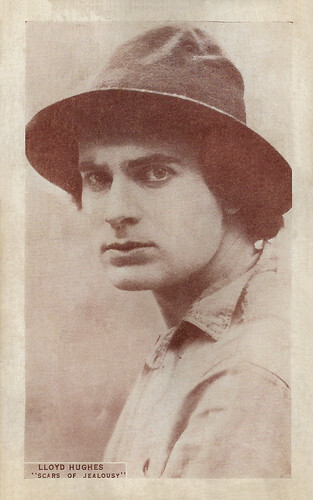
American postcard. Photo: Lloyd Hughes in Scars of Jealousy (Lambert Hillyer, 1923).
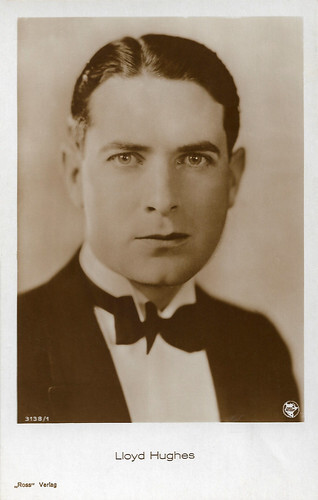
German postcard by Ross Verlag, no. 3138/1, 1928-1929. Photo: First National / Defina.
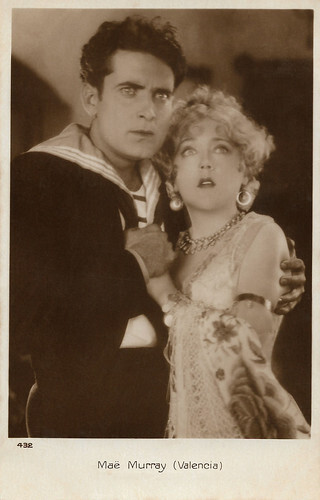
French postcard, no. 432. Mae Murray and Lloyd Hughes in the American silent film Valencia (Dimitri Buchowetzki, 1926).
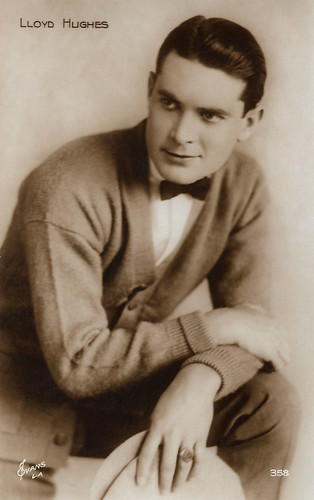
French postcard by Cinémagazine-Edition, Paris, no. 358. Photo: Evans, L.A.
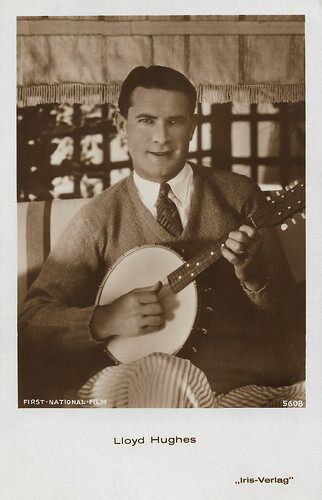
Austrian postcard by Iris-Verlag, no. 5608. Photo: First National Film.
The Sea Hawk
Lloyd Hughes was born in Bisbee, Arizona, in 1897. Hughes received his education at the Los Angeles Polytechnic School.
He sought a career as an actor early in life, and one of his first film appearances was a bit part in the silent drama Old Wives for New (Cecil B. DeMille, 1918). His clean-cut appearance and acting ability soon gained him recognition. he had bigger roles in The Turn in the Road (King Cidor, 1919), The Haunted Bedroom (Fred Niblo, 1919), and The Virtuous Thief (Fred Niblo, 1919) with Enid Bennett .
His first role as a leading man was in Dangerous Hours (Fred Niblo, 1919), which tells the story of an attempted Russian infiltration of the American industry. He had his breakthrough opposite Mary Pickford in the melodrama Tess of the Storm Country (John S. Robertson, 1921). Other roles included Love Never Dies (King Vidor, 1921) opposite Madge Bellamy , Mother o' Mine (Fred Niblo, 1921) with Betty Blythe , and Children of Dust (Frank Borzage, 1923).
A huge success was the adventure film The Sea Hawk (Frank Lloyd, 1924) about an English noble ( Milton Sills ) sold into slavery who escapes and turns himself into a pirate king. In this screen adaptation of the 1915 Rafael Sabatini novel of the same name, Hughes played his malicious half-brother. When the film was released, the New York Times critic called it: "far and away the best sea story that's yet been done up to that point".
Another success was the silent fantasy The Lost World (Harry O. Hoyt, 1925) adapted from Arthur Conan Doyle's 1912 novel of the same name, and starring Wallace Beery as Professor Challenger. It featured pioneering stop-motion special effects by Willis O'Brien, a forerunner of his work on the original King Kong (1933). Hughes appeared opposite Mae Murray in the romance Valencia (Dimitri Buchowetzki, 1926). The film was another box office hit and the title song, 'Valencia', was the top song in the U.S. for the year. Then followed a series of romantic comedies and dramas with Colleen Moore , Mary Astor , and Billie Dove .
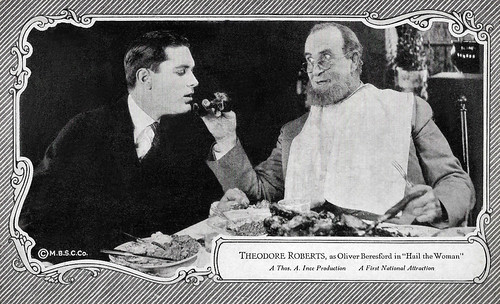
American postcard by Max B. Sheffer Card Co., Chicago (M.B.S.C.Co.), 1922. Photo: First National. Lloyd Hughes (left) and Theodore Roberts as Oliver Beresford in Hail the Woman (Thomas Ince, 1921).
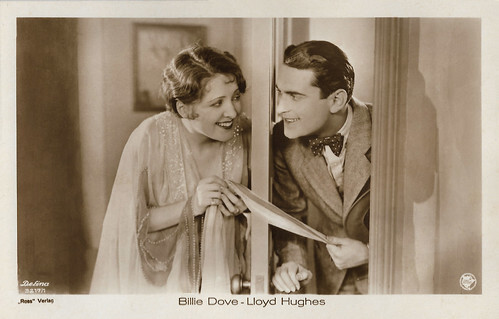
German postcard by Ross Verlag, no. 3217/1, 1928-1929. Photo: Defina / First National. Billie Dove and Lloyd Hughes in An Affair of the Follies (Millard Webb, 1927).

Italian postcard by Casa Editrice Ballerini & Fratini, no. 608. Photo: Metro-Goldwyn-Mayer, Roma. Mae Murray and Lloyd Hughes in Valencia (Dimitri Buchowetzki, 1926).
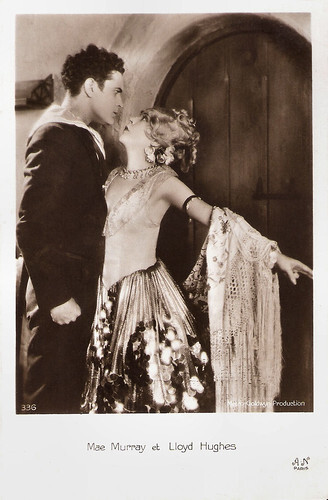
French postcard by A.N, Paris, no. 36. Photo: Metro-Goldwyn Production. Mae Murray and Lloyd Hughes in Valencia (Dimitri Buchowetzki, 1926).
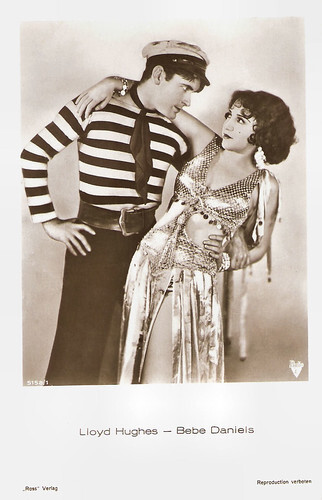
German postcard by Ross Verlag, no. 5158/1, 1930-1931. Photo: Radio Pictures (RKO). Lloyd Hughes and Bebe Daniels in Love Comes Along (Rupert Julian, 1930).
The Mysterious Island
Lloyd Hughes made the transition to sound and worked as an actor through the late 1930s. With Lionel Barrymore , he acted in the Science-Fiction film The Mysterious Island (Lucien Hubbard, 1929) based on Jules Verne's 1874 novel 'L'Île mystérieuse' (The Mysterious Island). It was photographed largely in two-color Technicolor and released by Metro-Goldwyn-Mayer as a part-talkie.
Then he co-starred with John Barrymore in the film, Moby Dick (Lloyd Bacon, 1930), the first adaption film of Herman Melville's 1851 novel 'Moby Dick' which includes a soundtrack.
Hughes had a supporting part in the pre-code drama The Miracle Man (Norman Z. McLeod, 1932) starring Sylvia Sidney .
His films soon became less prestigious. He appeared in B-films like Midnight Phantom (Bernard B. Ray, 1935) by Reliable Pictures and Kelly of the Secret Service (Robert F. Hill, 1936) by Victory Pictures. In Australia, he appeared in a couple of films including the drama The Broken Melody (Ken G. Hall, 1938).
After a supporting part in the adventure film Romance of the Redwoods (Charles Vidor, 1939), his film career was over. Hughes had met his wife, Gloria Hope, on the set of Tess of the Storm Country. The couple had two children: a son, Donald Reid Hughes (1926), and a daughter, Isabel Francies Hughes (1932). Lloyd Hughes died in 1958 in San Gabriel, California. He was 60.
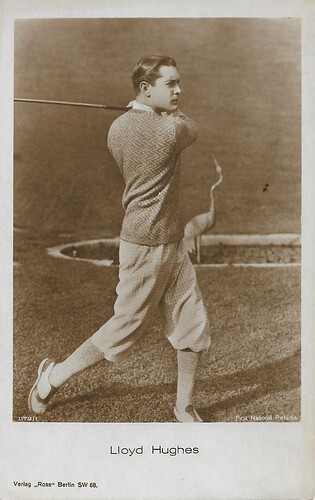
German postcard by Ross Verlag, Berlin, no. 1178/1. Photo: First National Pictures.
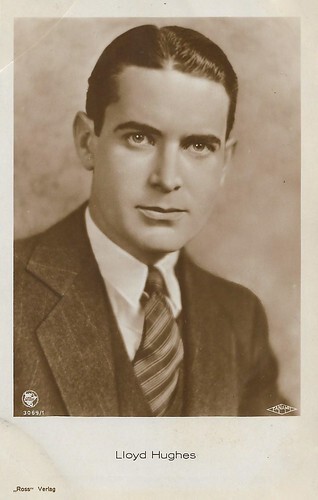
German-Italian postcard by Ross Verlag, no. 3069/1. On the back: Ed. Ballerini & Fratini, Firenze. Photo: First National / Fanamet.
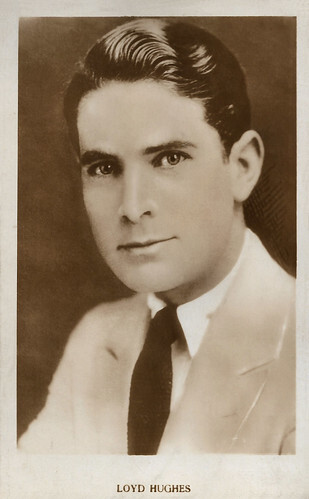
Czech postcard by M. Naki, Praha.
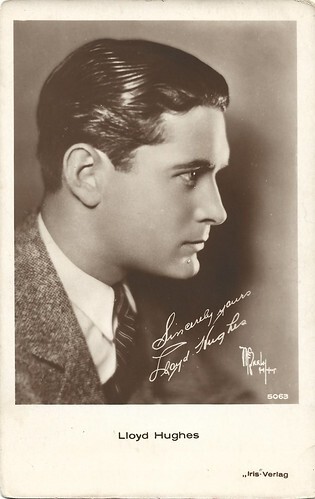
Austrian postcard by Iris Verlag, no. 5063. Photo by Walter Fredrick Seely, Los Angeles. In the 1910s and early 1920s, Seely (1886-1959) was the head photographer for the studio of Albert Witzel, but around 1922 he started his own studio. Trained as a landscape painter, Seely was also an acclaimed painter, who in the last years of his life (1957-59) was the president of the California Art Club. After Seely left Witzel, Max Munn Autrey took over at Witzel's until he started for himself too.
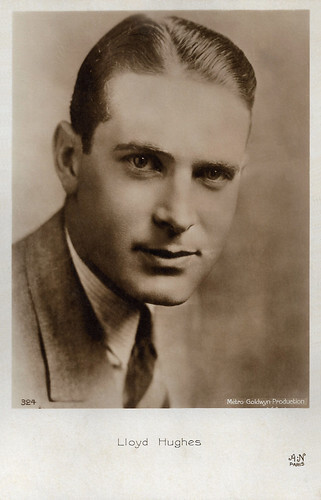
French postcard by A.N., Paris, no. 324. Photo: Metro-Goldwyn-Mayer.
Sources: Wikipedia and .

American postcard. Photo: Lloyd Hughes in Scars of Jealousy (Lambert Hillyer, 1923).

German postcard by Ross Verlag, no. 3138/1, 1928-1929. Photo: First National / Defina.

French postcard, no. 432. Mae Murray and Lloyd Hughes in the American silent film Valencia (Dimitri Buchowetzki, 1926).

French postcard by Cinémagazine-Edition, Paris, no. 358. Photo: Evans, L.A.

Austrian postcard by Iris-Verlag, no. 5608. Photo: First National Film.
The Sea Hawk
Lloyd Hughes was born in Bisbee, Arizona, in 1897. Hughes received his education at the Los Angeles Polytechnic School.
He sought a career as an actor early in life, and one of his first film appearances was a bit part in the silent drama Old Wives for New (Cecil B. DeMille, 1918). His clean-cut appearance and acting ability soon gained him recognition. he had bigger roles in The Turn in the Road (King Cidor, 1919), The Haunted Bedroom (Fred Niblo, 1919), and The Virtuous Thief (Fred Niblo, 1919) with Enid Bennett .
His first role as a leading man was in Dangerous Hours (Fred Niblo, 1919), which tells the story of an attempted Russian infiltration of the American industry. He had his breakthrough opposite Mary Pickford in the melodrama Tess of the Storm Country (John S. Robertson, 1921). Other roles included Love Never Dies (King Vidor, 1921) opposite Madge Bellamy , Mother o' Mine (Fred Niblo, 1921) with Betty Blythe , and Children of Dust (Frank Borzage, 1923).
A huge success was the adventure film The Sea Hawk (Frank Lloyd, 1924) about an English noble ( Milton Sills ) sold into slavery who escapes and turns himself into a pirate king. In this screen adaptation of the 1915 Rafael Sabatini novel of the same name, Hughes played his malicious half-brother. When the film was released, the New York Times critic called it: "far and away the best sea story that's yet been done up to that point".
Another success was the silent fantasy The Lost World (Harry O. Hoyt, 1925) adapted from Arthur Conan Doyle's 1912 novel of the same name, and starring Wallace Beery as Professor Challenger. It featured pioneering stop-motion special effects by Willis O'Brien, a forerunner of his work on the original King Kong (1933). Hughes appeared opposite Mae Murray in the romance Valencia (Dimitri Buchowetzki, 1926). The film was another box office hit and the title song, 'Valencia', was the top song in the U.S. for the year. Then followed a series of romantic comedies and dramas with Colleen Moore , Mary Astor , and Billie Dove .

American postcard by Max B. Sheffer Card Co., Chicago (M.B.S.C.Co.), 1922. Photo: First National. Lloyd Hughes (left) and Theodore Roberts as Oliver Beresford in Hail the Woman (Thomas Ince, 1921).

German postcard by Ross Verlag, no. 3217/1, 1928-1929. Photo: Defina / First National. Billie Dove and Lloyd Hughes in An Affair of the Follies (Millard Webb, 1927).

Italian postcard by Casa Editrice Ballerini & Fratini, no. 608. Photo: Metro-Goldwyn-Mayer, Roma. Mae Murray and Lloyd Hughes in Valencia (Dimitri Buchowetzki, 1926).

French postcard by A.N, Paris, no. 36. Photo: Metro-Goldwyn Production. Mae Murray and Lloyd Hughes in Valencia (Dimitri Buchowetzki, 1926).

German postcard by Ross Verlag, no. 5158/1, 1930-1931. Photo: Radio Pictures (RKO). Lloyd Hughes and Bebe Daniels in Love Comes Along (Rupert Julian, 1930).
The Mysterious Island
Lloyd Hughes made the transition to sound and worked as an actor through the late 1930s. With Lionel Barrymore , he acted in the Science-Fiction film The Mysterious Island (Lucien Hubbard, 1929) based on Jules Verne's 1874 novel 'L'Île mystérieuse' (The Mysterious Island). It was photographed largely in two-color Technicolor and released by Metro-Goldwyn-Mayer as a part-talkie.
Then he co-starred with John Barrymore in the film, Moby Dick (Lloyd Bacon, 1930), the first adaption film of Herman Melville's 1851 novel 'Moby Dick' which includes a soundtrack.
Hughes had a supporting part in the pre-code drama The Miracle Man (Norman Z. McLeod, 1932) starring Sylvia Sidney .
His films soon became less prestigious. He appeared in B-films like Midnight Phantom (Bernard B. Ray, 1935) by Reliable Pictures and Kelly of the Secret Service (Robert F. Hill, 1936) by Victory Pictures. In Australia, he appeared in a couple of films including the drama The Broken Melody (Ken G. Hall, 1938).
After a supporting part in the adventure film Romance of the Redwoods (Charles Vidor, 1939), his film career was over. Hughes had met his wife, Gloria Hope, on the set of Tess of the Storm Country. The couple had two children: a son, Donald Reid Hughes (1926), and a daughter, Isabel Francies Hughes (1932). Lloyd Hughes died in 1958 in San Gabriel, California. He was 60.

German postcard by Ross Verlag, Berlin, no. 1178/1. Photo: First National Pictures.

German-Italian postcard by Ross Verlag, no. 3069/1. On the back: Ed. Ballerini & Fratini, Firenze. Photo: First National / Fanamet.

Czech postcard by M. Naki, Praha.

Austrian postcard by Iris Verlag, no. 5063. Photo by Walter Fredrick Seely, Los Angeles. In the 1910s and early 1920s, Seely (1886-1959) was the head photographer for the studio of Albert Witzel, but around 1922 he started his own studio. Trained as a landscape painter, Seely was also an acclaimed painter, who in the last years of his life (1957-59) was the president of the California Art Club. After Seely left Witzel, Max Munn Autrey took over at Witzel's until he started for himself too.

French postcard by A.N., Paris, no. 324. Photo: Metro-Goldwyn-Mayer.
Sources: Wikipedia and .
Published on October 23, 2023 22:00
October 22, 2023
Lida Baarova
Beautiful Lída Baarová (1914-2000) was a glamorous Czech film star who worked in Prague, Berlin and Rome. A dangerous affair with Joseph Goebbels, the propaganda minister of the Third Reich, first enhanced and later seriously damaged her career.
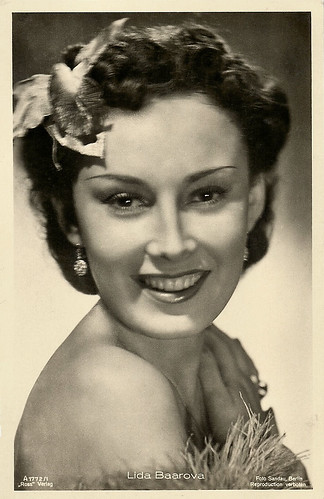
German postcard by Ross Verlag, no. A 1772/1, 1937-1938. Photo: Sandau, Berlin. Collection: Didier Hanson.
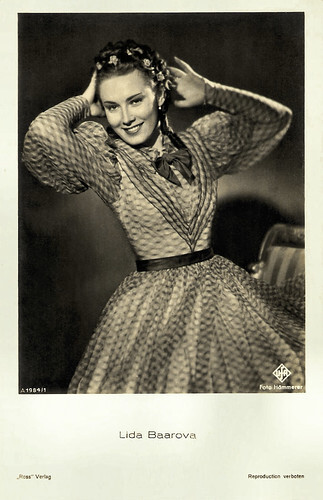
German postcard by Ross Verlag, no. A 1984/1, 1937-1938. Photo: Hämmerer / Ufa.
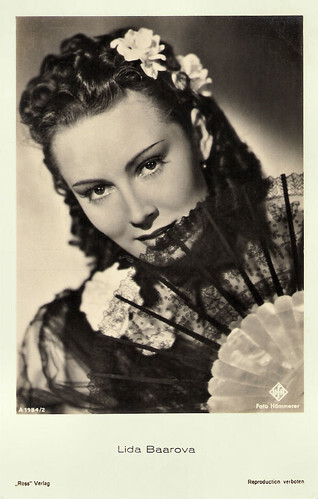
German postcard by Ross Verlag, no. A 1984/2, 1937-1938. Photo: Hämmerer / Ufa.
From Prague to Berlin
Lída Baarová was born Lidmila Babková in Prague, Austria-Hungary (now Czech Republic) in 1914. Her father was a civil servant, her mother appeared in several theatre plays and her younger sister, Zorka Janů, also was a film actress. From 1927 on, Lidmila studied acting at the State Conservatory in Prague. At the age of 17, she made her film debut as Lída Baarová in the Czech comedy Kariéra Pavla Camrdy/Pavel Čamrda's Career (Miroslav Josef Krnanský, 1931) starring Vladimír Borský . The film was a success but Lída had to leave the conservatory while students were not allowed to accept film roles. It did not matter.
The following year she played the lead in the comedies Madla z cihelny/The Brickmaker's Daughter (Vladimír Slavínský, 1932) with Hugo Haas, and Lelícek ve sluzbách Sherlocka Holmese/Lelícek in the service of Sherlock Holmes (Karel Lamač, 1932) featuring Martin Fric as Sherlock Holmes. Director Karel Lamač a.k.a. Carl Lamac and Baarová reportedly had an affair. The exceptionally beautiful actress starred in a dozen more Czech films, performed on stage and recorded some songs before she was discovered by a talent scout for the Ufa in 1934. Baarova left Prague for Berlin, where the Ufa studio groomed her as a star. At the set of the drama Barcarole (Gerhard Lamprecht, 1935), she met German actor Gustav Fröhlich , who became her new lover. The film was a success and the couple starred in several films together, such as Leutnant Bobby, der Teufelskerl/A Devil of a Fellow (Georg Jacoby, 1935) and Die Stunde der Versuchung/The Hour of Trial (Paul Wegener, 1936).
After Fröhlich had divorced his wife, the Jewish operetta star Gitta Alpár , he and Baarová moved to a villa on the picturesque Wannsee. There they lived near to the residence of Joseph Goebbels. Goebbels was the propaganda minister in Adolf Hitler's National Socialist government, with a decisive voice in German film production. Baarová met Goebbels at the Olympic Games of 1936. He ardently pursued her, entertaining her in his villa and lavishing her with expensive gifts. They started a relationship that lasted over two years.
In 1937, she received a job offer from Hollywood but turned it down. Later she would regret it and claimed to her biographer Josef Škvorecký: "I could have been as famous as Marlene Dietrich ." For a while, her affair with the Propaganda Minister did her career no harm. She starred as an exotic vamp in such films as Patrioten/Patriots (Karl Ritter, 1937) with Mathias Wieman , Die Fledermaus/The Bat (Paul Verhoeven, Hans H. Zerlett, 1937) with Hans Söhnker , and the Fyodor Dostoevsky adaptation Der Spieler/The Gambler (Gerhard Lamprecht, 1938). She also had stage engagements at the prestigious Deutsche Theater and the Volksbühne.
However, the liaison caused serious complications between Goebbels and his wife Magda. Hitler was furious, refusing Goebbels's permission to divorce Magda and marry Baarová. Instead, he commanded Goebbels never to see his mistress again. Through the head of the Berlin police, Hitler ordered her extradition. Baarová was barred from appearing in films or plays and even from attending social functions. She was pursued by the Gestapo, who organised hecklers to shout ‘Whore’ when she defiantly attended the premiere of her film, Der Spieler.
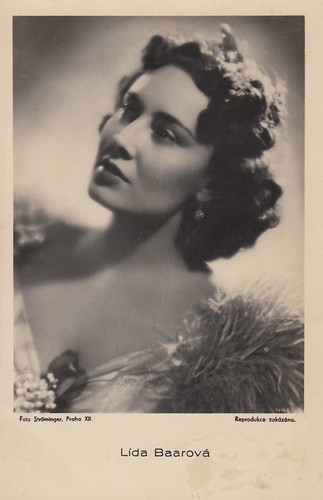
Czech postcard, no. 448. Photo: Ströminger, Praha (Prague). Collection: Marlene Pilaete.
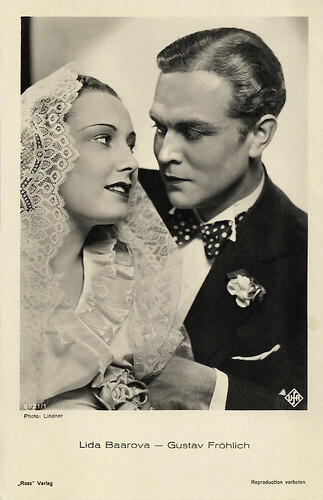
German postcard by Ross Verlag, no. 9021/1, 1935-1936. Photo: Ufa / Lindner. Lida Baarova and Gustav Fröhlich in Barcarole (Gerhard Lamprecht, 1936).
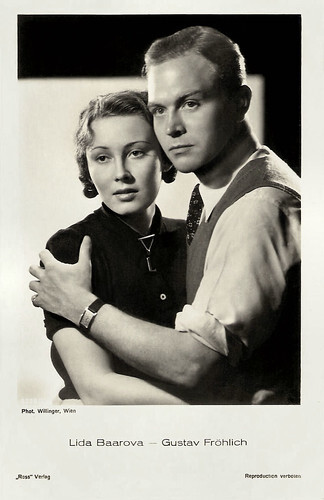
German postcard by Ross Verlag, no. 9228/1, 1935-1936. Photo: Willinger, Wien. Lida Baarova and Gustav Fröhlich .
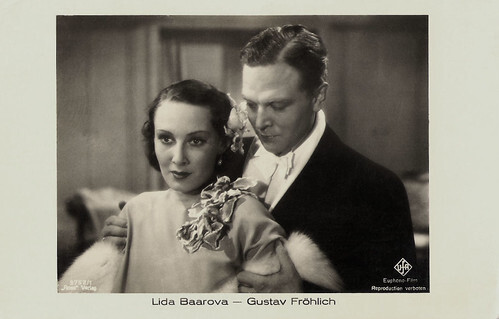
German postcard by Ross Verlag, no. 9758/1, 1935-1936. Photo: Ufa / Euphono Film. Lida Baarova and Gustav Fröhlich in Die Stunde der Versuchung/The Hour of Temptation (Paul Wegener, 1936).
From Berlin to Prague to Rome
In 1939, Lída Baarová fled to Prague and there she continued to play in films like Ohnivé léto/Fiery Summer (Frantisek Cáp, Václav Krska, 1939), Dívka v modrém/Girl in blue (Otakar Vávra, 1940), Maskovana milenka/Masked Paramour (Otakar Vávra, 1940) with Ewald Balser , and Zivot je krásný/Life Is Beautiful (Ladislav Brom, 1940).
But the Germans invaded Prague in March 1939, and soon she could not continue to film in her homeland. In 1942, she moved on to Benito Mussolini’s Italy, where she starred in such films as La Fornarina (Enrico Guazzoni, 1944) with Anneliese Uhlig , L'ippocampo/The Sea-Horse (Gian Paolo Rosmino, 1945) with Vittorio de Sica , and Vivere ancora/Still Alive (Nino Giannini, 1945) starring Gino Cervi .
After Allied troops occupied Italy, Lída Baarová returned to Prague. There she dated her old friend, German film idol Hans Albers . In April 1945, Lída Baarová left Prague for Germany, to join Albers in his country house on the shores of Lake Starnberg. On the way, she was taken into custody by the American military police, imprisoned in Munich, and later extradited to Czechoslovakia. Baarová was taken into custody on suspicion of collaboration with the Germans during the war. After a police hearing Baarová’s mother got a heart attack and died. Zorka Janů, who never had any ties to the Nazis, got as Baarová’sister also a Berufsverbot to make films and committed suicide in 1946.
After 18 months of custody, Lída Baarová was released due to lack of evidence. While in custody, she was often visited by an admirer, theatrical agent Jan Kopecký. He was a close relative of the Czech Communist Minister of the Interior and hoped he could arrange Baarova's release from custody. Kopecký's prominent relative did not approve of this and Kopecký himself faced persecution. Kopecký and Lída Baarová married in 1947, formed an itinerant troupe playing marionettes and fled to Austria.
From there, Kopecký immigrated to Argentina, leaving Lída behind to recuperate in a sanatorium. In Austria, Lída attempted a comeback, but Anton Walbrook withdrew from a film where he was cast with her. To escape the resulting negative media, she left for Argentina, where she lived in poverty. In 1950, she decided to return to Italy. Her husband stayed in Argentina and they were divorced in 1956.
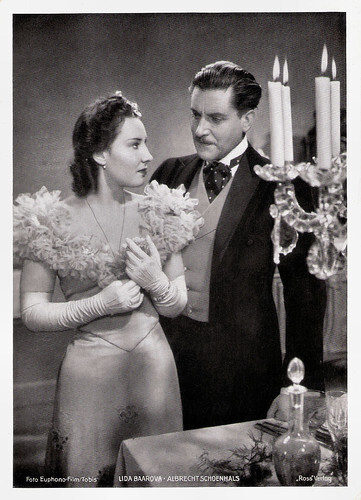
Large German card by Ross Verlag. Photo: Euphono-Film / Tobis. Lida Baarova and Albrecht Schoenhals in Einer Zuviel an Bord/One Too Many on Board (Gerhard Lamprecht, 1935).
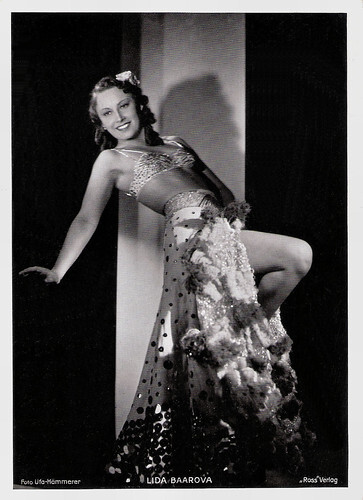
German card by Ross-Verlag. Photo: Hämmerer / Ufa.
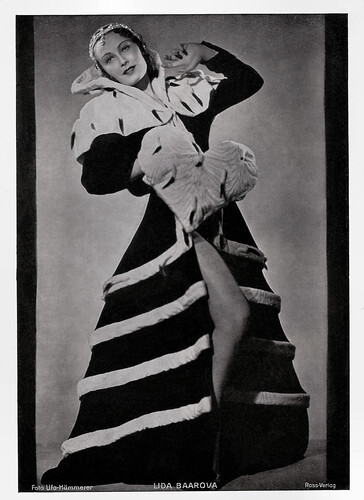
German card by Ross-Verlag. Photo: Hämmerer / Ufa.
Fellini
Back in Italy, Lida Baarová appeared in several films, including La bisarca/The Transporter (Giorgio Simonelli, 1950) with comedian Peppino De Filippo and Gli amanti di Ravello/The Lovers of Ravello (Luigi Capuano, 1951) opposite Gabriele Ferzetti .
Her best-known film is I Vitelloni/The Loafers (Federico Fellini, 1953), where she played the wife of a rich merchant. Later films include Pietà per chi cade/Compassion for those who fall (Mario Costa, 1954) starring Amedeo Nazzari and the Spanish production Miedo/Fear (León Klimovsky, 1956) in which she played the wife of Antonio Vilar. Her final film was the war film Il cielo brucia/The Sky Burns (Giuseppe Masini, 1958) with Amedeo Nazzari and Antonella Lualdi .
In 1958, Baarova moved to Salzburg, In 1960, she began her theatrical comeback at the Theater an der Berliner Allee in Düsseldorf in a play by Claude Magnier. She married Swedish physician Kurt Lundwall in 1969 (some sources say 1972), who was 20 years her senior. By 1975 she was appearing in the German stage version of Rainer Werner Fassbinder 's 'The Bitter Tears of Petra Von Kant'.
In the 1990s, after the fall of Communism, Baarová reappeared on the cultural scene of the Czech Republic. With the help of the Czech author Josef Škvorecký she published 1983 the autobiography 'Útěky' (Escapes) and in 1991 followed 'Život sladké hořkosti' (The Sweet Bitterness of My Life). In this memoir, she described life in the Nazi upper echelons, where elegantly dressed ministers mingled with the film world elite. The short documentary Sladke horkosti Lidy Baarove/Lída Baarová's Bittersweet Memories (1995) won an award at the 1996 Art Film Festival in Trenčianske Teplice, Slovakia.
Baarová suffered from Parkinson's disease and she died in 2000 in Salzburg, Austria. She was 86. She lived alone on the estate she inherited after the death of her second husband, Dr. Lundwall, who passed away in 1972 (some sources say 1980). In her autobiography, she stated that later in her life she regretted that she had been mixed up in ‘the history’. But at that time she was very young and ‘foolish’ and couldn't help seeing Goebbels. However, it is doubtful that she ever really felt guilt about her past. "There's no doubt that Goebbels was an interesting character," she observed in 1997, "a charming and intelligent man and a very good storyteller. You could guarantee that he would keep a party going with his little asides and jokes." Her ashes were interred in Prague's Strašnice cemetery, where she rests with her parents and her sister Zorka Janů.
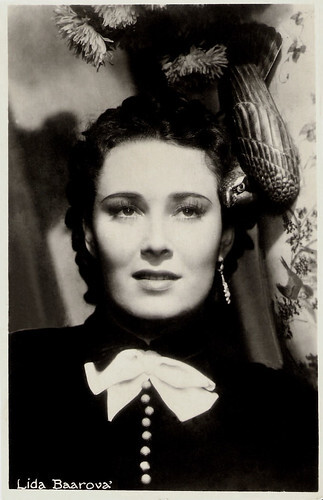
German postcard by Agfa.
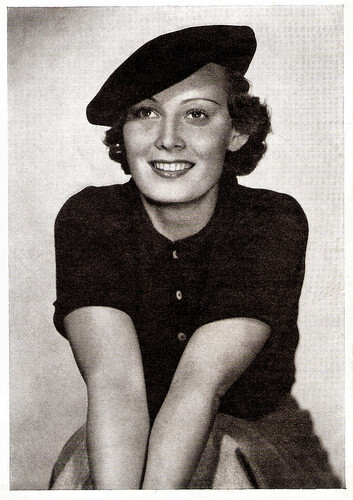
German postcard by Linden-Verlag, Leipzig, a supplement of the magazine Unterm Lindenbaum, no. V/21. Photo: Binder.
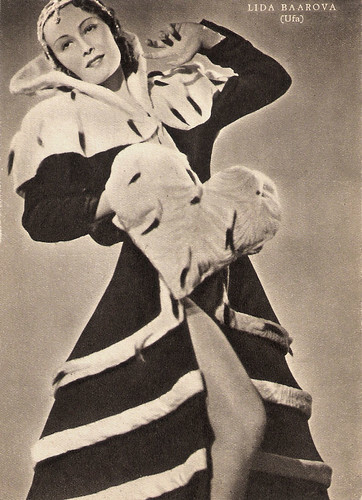
Italian postcard by Rizzoli, Milano, 1939, XVIII. Photo: Hämmerer / Ufa.
Lida Baarová sings Růže nad moji mrizi in Dívka v modrém/Girl in blue (1940). Source: Filmexporthomevideo (YouTube).
Sources: Peter Conradi (The Sunday Times), The Guardian, Wolf Oschlies (Shoa.de - now defunct), Wikipedia (German and English), and .

German postcard by Ross Verlag, no. A 1772/1, 1937-1938. Photo: Sandau, Berlin. Collection: Didier Hanson.

German postcard by Ross Verlag, no. A 1984/1, 1937-1938. Photo: Hämmerer / Ufa.

German postcard by Ross Verlag, no. A 1984/2, 1937-1938. Photo: Hämmerer / Ufa.
From Prague to Berlin
Lída Baarová was born Lidmila Babková in Prague, Austria-Hungary (now Czech Republic) in 1914. Her father was a civil servant, her mother appeared in several theatre plays and her younger sister, Zorka Janů, also was a film actress. From 1927 on, Lidmila studied acting at the State Conservatory in Prague. At the age of 17, she made her film debut as Lída Baarová in the Czech comedy Kariéra Pavla Camrdy/Pavel Čamrda's Career (Miroslav Josef Krnanský, 1931) starring Vladimír Borský . The film was a success but Lída had to leave the conservatory while students were not allowed to accept film roles. It did not matter.
The following year she played the lead in the comedies Madla z cihelny/The Brickmaker's Daughter (Vladimír Slavínský, 1932) with Hugo Haas, and Lelícek ve sluzbách Sherlocka Holmese/Lelícek in the service of Sherlock Holmes (Karel Lamač, 1932) featuring Martin Fric as Sherlock Holmes. Director Karel Lamač a.k.a. Carl Lamac and Baarová reportedly had an affair. The exceptionally beautiful actress starred in a dozen more Czech films, performed on stage and recorded some songs before she was discovered by a talent scout for the Ufa in 1934. Baarova left Prague for Berlin, where the Ufa studio groomed her as a star. At the set of the drama Barcarole (Gerhard Lamprecht, 1935), she met German actor Gustav Fröhlich , who became her new lover. The film was a success and the couple starred in several films together, such as Leutnant Bobby, der Teufelskerl/A Devil of a Fellow (Georg Jacoby, 1935) and Die Stunde der Versuchung/The Hour of Trial (Paul Wegener, 1936).
After Fröhlich had divorced his wife, the Jewish operetta star Gitta Alpár , he and Baarová moved to a villa on the picturesque Wannsee. There they lived near to the residence of Joseph Goebbels. Goebbels was the propaganda minister in Adolf Hitler's National Socialist government, with a decisive voice in German film production. Baarová met Goebbels at the Olympic Games of 1936. He ardently pursued her, entertaining her in his villa and lavishing her with expensive gifts. They started a relationship that lasted over two years.
In 1937, she received a job offer from Hollywood but turned it down. Later she would regret it and claimed to her biographer Josef Škvorecký: "I could have been as famous as Marlene Dietrich ." For a while, her affair with the Propaganda Minister did her career no harm. She starred as an exotic vamp in such films as Patrioten/Patriots (Karl Ritter, 1937) with Mathias Wieman , Die Fledermaus/The Bat (Paul Verhoeven, Hans H. Zerlett, 1937) with Hans Söhnker , and the Fyodor Dostoevsky adaptation Der Spieler/The Gambler (Gerhard Lamprecht, 1938). She also had stage engagements at the prestigious Deutsche Theater and the Volksbühne.
However, the liaison caused serious complications between Goebbels and his wife Magda. Hitler was furious, refusing Goebbels's permission to divorce Magda and marry Baarová. Instead, he commanded Goebbels never to see his mistress again. Through the head of the Berlin police, Hitler ordered her extradition. Baarová was barred from appearing in films or plays and even from attending social functions. She was pursued by the Gestapo, who organised hecklers to shout ‘Whore’ when she defiantly attended the premiere of her film, Der Spieler.

Czech postcard, no. 448. Photo: Ströminger, Praha (Prague). Collection: Marlene Pilaete.

German postcard by Ross Verlag, no. 9021/1, 1935-1936. Photo: Ufa / Lindner. Lida Baarova and Gustav Fröhlich in Barcarole (Gerhard Lamprecht, 1936).

German postcard by Ross Verlag, no. 9228/1, 1935-1936. Photo: Willinger, Wien. Lida Baarova and Gustav Fröhlich .

German postcard by Ross Verlag, no. 9758/1, 1935-1936. Photo: Ufa / Euphono Film. Lida Baarova and Gustav Fröhlich in Die Stunde der Versuchung/The Hour of Temptation (Paul Wegener, 1936).
From Berlin to Prague to Rome
In 1939, Lída Baarová fled to Prague and there she continued to play in films like Ohnivé léto/Fiery Summer (Frantisek Cáp, Václav Krska, 1939), Dívka v modrém/Girl in blue (Otakar Vávra, 1940), Maskovana milenka/Masked Paramour (Otakar Vávra, 1940) with Ewald Balser , and Zivot je krásný/Life Is Beautiful (Ladislav Brom, 1940).
But the Germans invaded Prague in March 1939, and soon she could not continue to film in her homeland. In 1942, she moved on to Benito Mussolini’s Italy, where she starred in such films as La Fornarina (Enrico Guazzoni, 1944) with Anneliese Uhlig , L'ippocampo/The Sea-Horse (Gian Paolo Rosmino, 1945) with Vittorio de Sica , and Vivere ancora/Still Alive (Nino Giannini, 1945) starring Gino Cervi .
After Allied troops occupied Italy, Lída Baarová returned to Prague. There she dated her old friend, German film idol Hans Albers . In April 1945, Lída Baarová left Prague for Germany, to join Albers in his country house on the shores of Lake Starnberg. On the way, she was taken into custody by the American military police, imprisoned in Munich, and later extradited to Czechoslovakia. Baarová was taken into custody on suspicion of collaboration with the Germans during the war. After a police hearing Baarová’s mother got a heart attack and died. Zorka Janů, who never had any ties to the Nazis, got as Baarová’sister also a Berufsverbot to make films and committed suicide in 1946.
After 18 months of custody, Lída Baarová was released due to lack of evidence. While in custody, she was often visited by an admirer, theatrical agent Jan Kopecký. He was a close relative of the Czech Communist Minister of the Interior and hoped he could arrange Baarova's release from custody. Kopecký's prominent relative did not approve of this and Kopecký himself faced persecution. Kopecký and Lída Baarová married in 1947, formed an itinerant troupe playing marionettes and fled to Austria.
From there, Kopecký immigrated to Argentina, leaving Lída behind to recuperate in a sanatorium. In Austria, Lída attempted a comeback, but Anton Walbrook withdrew from a film where he was cast with her. To escape the resulting negative media, she left for Argentina, where she lived in poverty. In 1950, she decided to return to Italy. Her husband stayed in Argentina and they were divorced in 1956.

Large German card by Ross Verlag. Photo: Euphono-Film / Tobis. Lida Baarova and Albrecht Schoenhals in Einer Zuviel an Bord/One Too Many on Board (Gerhard Lamprecht, 1935).

German card by Ross-Verlag. Photo: Hämmerer / Ufa.

German card by Ross-Verlag. Photo: Hämmerer / Ufa.
Fellini
Back in Italy, Lida Baarová appeared in several films, including La bisarca/The Transporter (Giorgio Simonelli, 1950) with comedian Peppino De Filippo and Gli amanti di Ravello/The Lovers of Ravello (Luigi Capuano, 1951) opposite Gabriele Ferzetti .
Her best-known film is I Vitelloni/The Loafers (Federico Fellini, 1953), where she played the wife of a rich merchant. Later films include Pietà per chi cade/Compassion for those who fall (Mario Costa, 1954) starring Amedeo Nazzari and the Spanish production Miedo/Fear (León Klimovsky, 1956) in which she played the wife of Antonio Vilar. Her final film was the war film Il cielo brucia/The Sky Burns (Giuseppe Masini, 1958) with Amedeo Nazzari and Antonella Lualdi .
In 1958, Baarova moved to Salzburg, In 1960, she began her theatrical comeback at the Theater an der Berliner Allee in Düsseldorf in a play by Claude Magnier. She married Swedish physician Kurt Lundwall in 1969 (some sources say 1972), who was 20 years her senior. By 1975 she was appearing in the German stage version of Rainer Werner Fassbinder 's 'The Bitter Tears of Petra Von Kant'.
In the 1990s, after the fall of Communism, Baarová reappeared on the cultural scene of the Czech Republic. With the help of the Czech author Josef Škvorecký she published 1983 the autobiography 'Útěky' (Escapes) and in 1991 followed 'Život sladké hořkosti' (The Sweet Bitterness of My Life). In this memoir, she described life in the Nazi upper echelons, where elegantly dressed ministers mingled with the film world elite. The short documentary Sladke horkosti Lidy Baarove/Lída Baarová's Bittersweet Memories (1995) won an award at the 1996 Art Film Festival in Trenčianske Teplice, Slovakia.
Baarová suffered from Parkinson's disease and she died in 2000 in Salzburg, Austria. She was 86. She lived alone on the estate she inherited after the death of her second husband, Dr. Lundwall, who passed away in 1972 (some sources say 1980). In her autobiography, she stated that later in her life she regretted that she had been mixed up in ‘the history’. But at that time she was very young and ‘foolish’ and couldn't help seeing Goebbels. However, it is doubtful that she ever really felt guilt about her past. "There's no doubt that Goebbels was an interesting character," she observed in 1997, "a charming and intelligent man and a very good storyteller. You could guarantee that he would keep a party going with his little asides and jokes." Her ashes were interred in Prague's Strašnice cemetery, where she rests with her parents and her sister Zorka Janů.

German postcard by Agfa.

German postcard by Linden-Verlag, Leipzig, a supplement of the magazine Unterm Lindenbaum, no. V/21. Photo: Binder.

Italian postcard by Rizzoli, Milano, 1939, XVIII. Photo: Hämmerer / Ufa.
Lida Baarová sings Růže nad moji mrizi in Dívka v modrém/Girl in blue (1940). Source: Filmexporthomevideo (YouTube).
Sources: Peter Conradi (The Sunday Times), The Guardian, Wolf Oschlies (Shoa.de - now defunct), Wikipedia (German and English), and .
Published on October 22, 2023 22:00
October 21, 2023
Diana Ross
Diana Ross (1944) is an American soul singer and film actress who became one of the most successful artists in the world. She rose to fame with The Supremes and then launched a successful solo career. She received an Oscar nomination for her debut role as Billie Holiday in the film Lady Sings the Blues (1973). From then on she became a dazzling superstar with such worldwide number-one hits as 'Upside Down', 'I'm Coming Out' and 'Endless Love'.
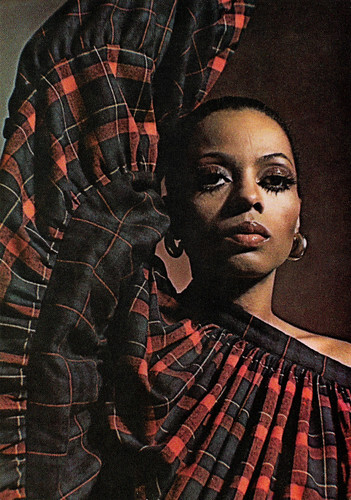
Dutch postcard by Art Promotion, Amsterdam. Photo: EMI / Bovema.
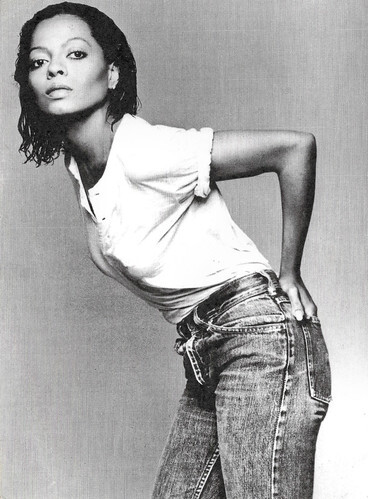
Vintage photo. Photo: Francesco Scavullo. Diana Ross on the cover photo of her album 'Diana' (1980).
Lady Sings the Blues
Diane Ernestine 'Diana' Ross was born in Detroit, Michigan, in 1944). She was the second daughter of Fred Ross Sr., a factory worker and Ernestine Moten, a teacher in a family of six children. After being raised in housing projects for most of the late 1940s and early 1950s, Diana started singing in the gospel choir of a Baptist church.
Together with Mary Wilson, Florence Ballard and Barbara Martin, she formed The Primettes, at age 15 in 1959. It was the sister group of a male vocal group called The Primes. They were brought to the attention of music manager Milton Jenkins by Primes member Paul Williams. After getting a contract with Motown in 1960, Barbara Martin left the group. The name of the group was changed to The Supremes in 1961. The trio's first singles turned out to be flops, but The Supremes had a notable hit in 1963 with 'When the Lovelight Starts Shining Through His Eyes'. Their breakthrough came in 1964 with the song 'Where Did Our Love Go'.
It was the first of twelve number-one hits for the Supremes on the US singles chart, including such classics as 'Stop! In the Name of Love' or 'You Keep Me Hangin' on'. In 1967, they became Diana Ross and the Supremes. Florence Ballard was fired by Motown owner Berry Gordy, after which Cindy Birdsong joined and they formed a singing trio again. The Supremes recorded several major hits during this period, almost all written and produced by the Holland-Dozier-Holland trio. In October 1969, Ross left the group and embarked on a solo career that also proved successful. Her first big hit was a new version of the Ashford & Simpson-written 'Ain't No Mountain High Enough' in 1970.
She then starred in a film adaptation of Billie Holiday's life, Lady Sings the Blues (Sidney J. Furie, 1972) with Richard Pryor and Billy Dee Williams. She received an Oscar nomination for her role. The accompanying soundtrack was one of Ross' biggest commercial successes and her only number-one on the US album charts. In 1973, she released an album of duets with Marvin Gaye under the title 'Diana and Marvin'. Several duets from this album became big hits.
In 1975, she returned to the big screen in the film Mahogany (Berry Gordy, 1975) with Billy Dee Williams and Anthony Perkins . The title song 'Do You Know Where You're Going To' became a No. 1 hit. Her second, self-titled album entered the top 10. In February 1976, just before another #1 hit with 'Love Hangover', she was stunned when her singing partner and friend, Florence Ballard, died after complications from a combination of alcohol abuse and long-term depression, which led to cardiac arrest. Ballard was only 32 years old and Ross was devastated by the loss.
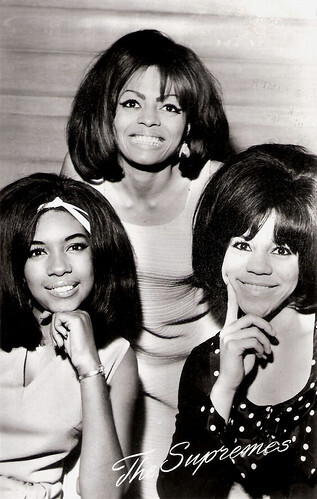
Dutch postcard by Muziek Parade, Hilversum, no. AX 6654. The most successful American performers of the 1960s, The Supremes for a time rivalled even The Beatles in terms of red-hot commercial appeal, reeling off five number-one singles in a row at one point.
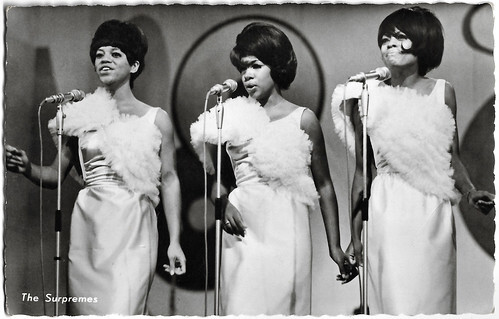
West German postcard by Filmbilder Verleih Ernst Freihoff, Essen, no. AX 6510.
The ultimate gay anthem
Diana Ross played the role of Dorothy in the film musical The Wiz (Sidney Lumet, 1978). It is the film adaptation of the 1975 Broadway musical of the same name. A striking feature is the cast that is entirely African-American with Michael Jackson performing the role of Scarecrow. The film is a modern version of the film The Wizard of Oz (Victor Fleming, 1939), which is based on the 1900-1920 stories about the Wizard of Oz by writer L. Frank Baum.
The songs 'Ease On Down The Road' and 'A Brand New Day' became hits. However, The Wiz itself, which at the time was the most expensive film musical ever made, proved to be a commercial failure, as its $24,000,000 production recouped only $13,600,000 at the cinema box office. The film's failure meant that Hollywood studios were no longer producing the all-black cast film projects that had become popular during the 1970s.
Particularly successful was the album 'The Boss', another Ashford & Simpson production, which reached number one on the disco charts and became a nickname for Ross. This success was surpassed by her collaboration with Nile Rodgers and Bernard Edwards of Chic, who produced her solo album 'Diana' in 1980 and wrote all the songs included.
Although Disco had lost a lot of popularity at that time, especially in the USA, the single 'Upside Down' reached number one in the charts, not only in the USA. It is still her biggest international hit. The following single from 'Diana', 'I'm Coming Out', was also an international success, with which Ross still opens her shows today. According to the musicians, Ross was not aware that Rodgers and Edwards were thinking of a homosexual coming out. They wanted to take advantage of Ross' great popularity with gays, especially with drag queens.
Decades later, Billboard magazine was still calling the song the "ultimate gay anthem" and Ross herself a "gay icon". In 1981, Ross's duet with Lionel Richie, 'Endless Love', proved to be the best-selling single of her career. It was her last hit on the Motown label. After this, she signed a $20 million contract with RCA for the US and Canada and EMI for the rest of the world.
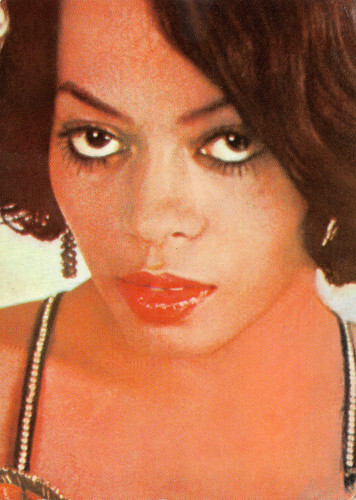
Romanian postcard by Casa Filmului Acin, no. C.P.C.S. 33 150.
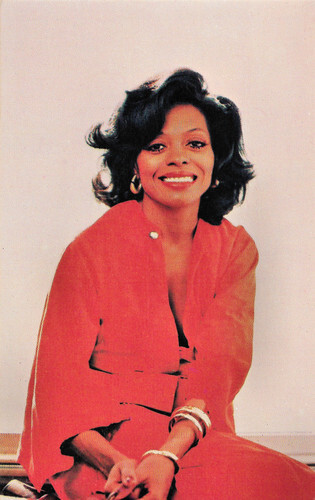
American postcard by Coral-Lee, Rancho Cordova, CA, no. Personality # 4, 1977, no. SC1768. Photo: Douglas Kirkland / Contact.
The Long Walk Out of the Night
Diana Ross's first platinum-selling album, 'Why Do Fools Fall in Love', was a worldwide success, with the title track, a cover of the Frankie Lymon & the Teenagers classic, reaching the Top 10 on the UK and US charts. Another single, 'Work That Body', had Ross as co-writer for the first time and again reached the Top 10 in the UK. Subsequent albums 'Silk Electric' (1982) and 'Swept Away' (1984) were also successful and received gold awards in the US.
Ross intensified her collaboration with famous colleagues, especially with regard to the singles charts. The hits in those years were 'Muscles', described by Rolling Stone as a "modern pop masterpiece", written and produced by Michael Jackson ; 'All of You', a duet with Spanish superstar Julio Iglesias ; 'Swept Away', written and produced by the successful pop duo Hall & Oates; and 'Eaten Alive', with Michael Jackson on backing vocals, written and produced by Barry Gibb.
'Chain Reaction' (1985), written by The Bee Gees, became a big hit in England and elsewhere, where it reached number 1. After a few more albums, she returned to Motown in the late 1980s. There she had a contract until 2001. Ross continued to be very successful as an entertainer on international tours, but sales of her records and CDs increasingly declined. Only Great Britain remained largely loyal to her. For example, her single 'When You Tell Me That You Love Me' reached second place in the British charts in 1991. In 1994, Ross played her first leading television role in the film The Long Walk Out of the Night (Larry Elikann, 1994). Her portrayal of a woman suffering from paranoid schizophrenia was critically acclaimed and earned her another Golden Globe nomination. In 1999, she followed it up with another television film, Double Platinum (Robert Allan Ackerman, 1999), alongside Brandy and songs from Ross' then-current album 'Every Day Is a New Day'. This is her last film work to date.
In 2006, Motown released 'Blue', an album of jazz songs that had been recorded in the early 1970s but never released. This album charted worldwide. Since 2018, Ross reached the number one spot on the US dance chart four times with remixes of her classic songs 'Ain't No Mountain High Enough' (2018), 'I'm Coming out/Upside Down' (2018), 'The Boss' (2019), and 'Love Hangover' (2020). In 2020, she released 'Supertonic Mixes', on which house producer Eric Kupper remixed her greatest hits. On 4 June 2022, she performed at the jubilee concert at Buckingham Palace in London to mark the 70th anniversary of the reign of Queen Elizabeth II.
Diana Ross was married twice: to Robert Ellis Silberstein from 1971 to 1977, and to Norwegian businessman Arne Næss from 1986 to 2000. Næss died in 2004 as a result of an accident while mountaineering in South Africa. Ross has two daughters with Silberstein, model and actress Tracee Joy (1972) and entertainer Chudney Lane (1975) and two sons with Næss, mountaineer and photographer Ross Arne (1987) and actor Evan Olav (1988). She also has a daughter with Berry Gordy, Rhonda Suzanne, who was born in 1971 when Ross was married to Silberstein for six months. Ross was also named in Michael Jackson 's will as guardian for the children after his death. In the summer of 2009, Ross became a grandmother for the first time. Her eldest daughter Rhonda gave birth to a baby boy. Two years later, Ross appeared on the talk show Oprah with all of her five children and her grandson.
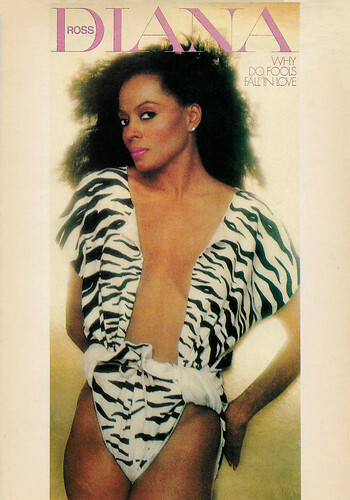
French postcard by Humour à la Carte, Paris, no. A-C 301. Photo: Douglas Kirkland. Cover photo for 'Why do fools fall in love' (1981).
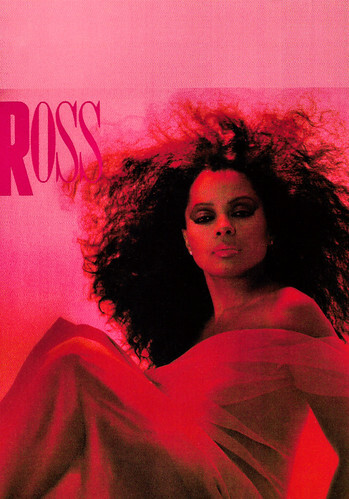
French postcard by Media Com + Promotion de l'Art de la Communication, no. Record 69. Photo: Uwe Ommer. Cover photo for 'Ross' (1983).
Sources: Wikipedia (Dutch, German and English), and .

Dutch postcard by Art Promotion, Amsterdam. Photo: EMI / Bovema.

Vintage photo. Photo: Francesco Scavullo. Diana Ross on the cover photo of her album 'Diana' (1980).
Lady Sings the Blues
Diane Ernestine 'Diana' Ross was born in Detroit, Michigan, in 1944). She was the second daughter of Fred Ross Sr., a factory worker and Ernestine Moten, a teacher in a family of six children. After being raised in housing projects for most of the late 1940s and early 1950s, Diana started singing in the gospel choir of a Baptist church.
Together with Mary Wilson, Florence Ballard and Barbara Martin, she formed The Primettes, at age 15 in 1959. It was the sister group of a male vocal group called The Primes. They were brought to the attention of music manager Milton Jenkins by Primes member Paul Williams. After getting a contract with Motown in 1960, Barbara Martin left the group. The name of the group was changed to The Supremes in 1961. The trio's first singles turned out to be flops, but The Supremes had a notable hit in 1963 with 'When the Lovelight Starts Shining Through His Eyes'. Their breakthrough came in 1964 with the song 'Where Did Our Love Go'.
It was the first of twelve number-one hits for the Supremes on the US singles chart, including such classics as 'Stop! In the Name of Love' or 'You Keep Me Hangin' on'. In 1967, they became Diana Ross and the Supremes. Florence Ballard was fired by Motown owner Berry Gordy, after which Cindy Birdsong joined and they formed a singing trio again. The Supremes recorded several major hits during this period, almost all written and produced by the Holland-Dozier-Holland trio. In October 1969, Ross left the group and embarked on a solo career that also proved successful. Her first big hit was a new version of the Ashford & Simpson-written 'Ain't No Mountain High Enough' in 1970.
She then starred in a film adaptation of Billie Holiday's life, Lady Sings the Blues (Sidney J. Furie, 1972) with Richard Pryor and Billy Dee Williams. She received an Oscar nomination for her role. The accompanying soundtrack was one of Ross' biggest commercial successes and her only number-one on the US album charts. In 1973, she released an album of duets with Marvin Gaye under the title 'Diana and Marvin'. Several duets from this album became big hits.
In 1975, she returned to the big screen in the film Mahogany (Berry Gordy, 1975) with Billy Dee Williams and Anthony Perkins . The title song 'Do You Know Where You're Going To' became a No. 1 hit. Her second, self-titled album entered the top 10. In February 1976, just before another #1 hit with 'Love Hangover', she was stunned when her singing partner and friend, Florence Ballard, died after complications from a combination of alcohol abuse and long-term depression, which led to cardiac arrest. Ballard was only 32 years old and Ross was devastated by the loss.

Dutch postcard by Muziek Parade, Hilversum, no. AX 6654. The most successful American performers of the 1960s, The Supremes for a time rivalled even The Beatles in terms of red-hot commercial appeal, reeling off five number-one singles in a row at one point.

West German postcard by Filmbilder Verleih Ernst Freihoff, Essen, no. AX 6510.
The ultimate gay anthem
Diana Ross played the role of Dorothy in the film musical The Wiz (Sidney Lumet, 1978). It is the film adaptation of the 1975 Broadway musical of the same name. A striking feature is the cast that is entirely African-American with Michael Jackson performing the role of Scarecrow. The film is a modern version of the film The Wizard of Oz (Victor Fleming, 1939), which is based on the 1900-1920 stories about the Wizard of Oz by writer L. Frank Baum.
The songs 'Ease On Down The Road' and 'A Brand New Day' became hits. However, The Wiz itself, which at the time was the most expensive film musical ever made, proved to be a commercial failure, as its $24,000,000 production recouped only $13,600,000 at the cinema box office. The film's failure meant that Hollywood studios were no longer producing the all-black cast film projects that had become popular during the 1970s.
Particularly successful was the album 'The Boss', another Ashford & Simpson production, which reached number one on the disco charts and became a nickname for Ross. This success was surpassed by her collaboration with Nile Rodgers and Bernard Edwards of Chic, who produced her solo album 'Diana' in 1980 and wrote all the songs included.
Although Disco had lost a lot of popularity at that time, especially in the USA, the single 'Upside Down' reached number one in the charts, not only in the USA. It is still her biggest international hit. The following single from 'Diana', 'I'm Coming Out', was also an international success, with which Ross still opens her shows today. According to the musicians, Ross was not aware that Rodgers and Edwards were thinking of a homosexual coming out. They wanted to take advantage of Ross' great popularity with gays, especially with drag queens.
Decades later, Billboard magazine was still calling the song the "ultimate gay anthem" and Ross herself a "gay icon". In 1981, Ross's duet with Lionel Richie, 'Endless Love', proved to be the best-selling single of her career. It was her last hit on the Motown label. After this, she signed a $20 million contract with RCA for the US and Canada and EMI for the rest of the world.

Romanian postcard by Casa Filmului Acin, no. C.P.C.S. 33 150.

American postcard by Coral-Lee, Rancho Cordova, CA, no. Personality # 4, 1977, no. SC1768. Photo: Douglas Kirkland / Contact.
The Long Walk Out of the Night
Diana Ross's first platinum-selling album, 'Why Do Fools Fall in Love', was a worldwide success, with the title track, a cover of the Frankie Lymon & the Teenagers classic, reaching the Top 10 on the UK and US charts. Another single, 'Work That Body', had Ross as co-writer for the first time and again reached the Top 10 in the UK. Subsequent albums 'Silk Electric' (1982) and 'Swept Away' (1984) were also successful and received gold awards in the US.
Ross intensified her collaboration with famous colleagues, especially with regard to the singles charts. The hits in those years were 'Muscles', described by Rolling Stone as a "modern pop masterpiece", written and produced by Michael Jackson ; 'All of You', a duet with Spanish superstar Julio Iglesias ; 'Swept Away', written and produced by the successful pop duo Hall & Oates; and 'Eaten Alive', with Michael Jackson on backing vocals, written and produced by Barry Gibb.
'Chain Reaction' (1985), written by The Bee Gees, became a big hit in England and elsewhere, where it reached number 1. After a few more albums, she returned to Motown in the late 1980s. There she had a contract until 2001. Ross continued to be very successful as an entertainer on international tours, but sales of her records and CDs increasingly declined. Only Great Britain remained largely loyal to her. For example, her single 'When You Tell Me That You Love Me' reached second place in the British charts in 1991. In 1994, Ross played her first leading television role in the film The Long Walk Out of the Night (Larry Elikann, 1994). Her portrayal of a woman suffering from paranoid schizophrenia was critically acclaimed and earned her another Golden Globe nomination. In 1999, she followed it up with another television film, Double Platinum (Robert Allan Ackerman, 1999), alongside Brandy and songs from Ross' then-current album 'Every Day Is a New Day'. This is her last film work to date.
In 2006, Motown released 'Blue', an album of jazz songs that had been recorded in the early 1970s but never released. This album charted worldwide. Since 2018, Ross reached the number one spot on the US dance chart four times with remixes of her classic songs 'Ain't No Mountain High Enough' (2018), 'I'm Coming out/Upside Down' (2018), 'The Boss' (2019), and 'Love Hangover' (2020). In 2020, she released 'Supertonic Mixes', on which house producer Eric Kupper remixed her greatest hits. On 4 June 2022, she performed at the jubilee concert at Buckingham Palace in London to mark the 70th anniversary of the reign of Queen Elizabeth II.
Diana Ross was married twice: to Robert Ellis Silberstein from 1971 to 1977, and to Norwegian businessman Arne Næss from 1986 to 2000. Næss died in 2004 as a result of an accident while mountaineering in South Africa. Ross has two daughters with Silberstein, model and actress Tracee Joy (1972) and entertainer Chudney Lane (1975) and two sons with Næss, mountaineer and photographer Ross Arne (1987) and actor Evan Olav (1988). She also has a daughter with Berry Gordy, Rhonda Suzanne, who was born in 1971 when Ross was married to Silberstein for six months. Ross was also named in Michael Jackson 's will as guardian for the children after his death. In the summer of 2009, Ross became a grandmother for the first time. Her eldest daughter Rhonda gave birth to a baby boy. Two years later, Ross appeared on the talk show Oprah with all of her five children and her grandson.

French postcard by Humour à la Carte, Paris, no. A-C 301. Photo: Douglas Kirkland. Cover photo for 'Why do fools fall in love' (1981).

French postcard by Media Com + Promotion de l'Art de la Communication, no. Record 69. Photo: Uwe Ommer. Cover photo for 'Ross' (1983).
Sources: Wikipedia (Dutch, German and English), and .
Published on October 21, 2023 22:00
October 20, 2023
Photo by Natge
Hans Natge was a German photographer who worked for the Ufa in the 1920s and 1930s and made several portraits of the stars of the Weimar cinema. He did still photography for some classic silent films, including F.W. Murnau's Der Letzte Mann (1924) and Faust (1926) and E. A. Dupont's Moulin Rouge (1928). He also worked as an assistant director and a director.
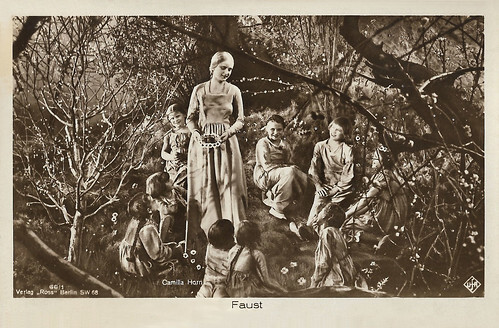
German postcard by Ross Verlag, Berlin, no. 66/1. Photo: Ufa. Camilla Horn in Faust (Friedrich Wilhelm Murnau, 1926).
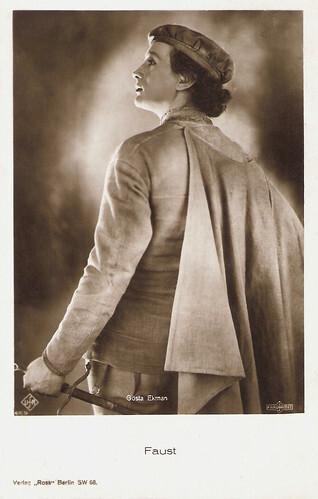
German postcard by Ross Verlag, no. 62/5. Photo: ParUfaMet / Ufa. Gösta Ekman in Faust (F.W. Murnau, 1926).
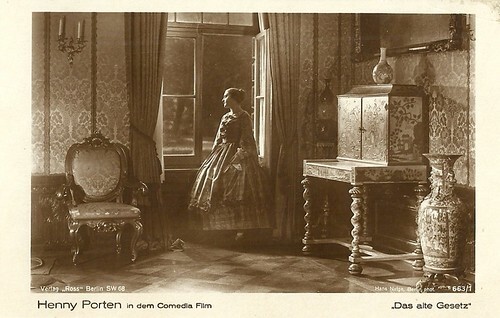
German postcard by Ross Verlag, no. 663/1. Photo: Hans Natge, Berlin / Comedia Film. Henny Porten in Das alte Gesetz (E.A. Dupont, 1923).
Sturdy and blond Henny Porten (1890-1960) was one of Germany's most important and popular film actresses of silent cinema. She became the quintessence of German womanhood, ladylike yet kindhearted and a not a little petit bourgeois. She was also the producer of many of her own films.
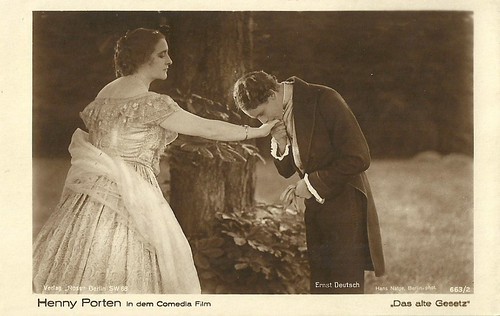
German postcard by Ross Verlag, no. 663/2. Photo: Hans Natge, Berlin / Comedia Film. Henny Porten and Ernst Deutsch in Das alte Gesetz (E.A. Dupont, 1923).
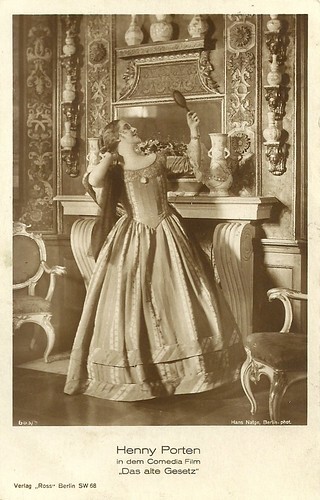
German postcard by Ross Verlag, no. 663/5. Photo: Hans Natge, Berlin. Henny Porten in Das alte Gesetz (E.A. Dupont, 1923).
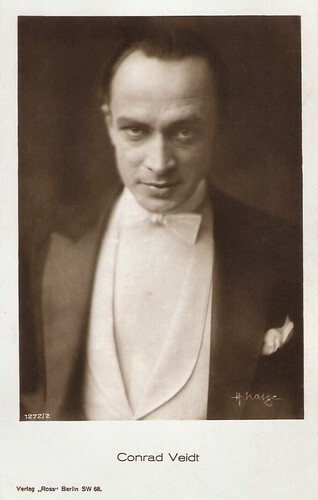
German postcard by Ross Verlag, Berlin, no. 1272/2, 1927-1928. Photo: Hans Natge.
Conrad Veidt (1893–1943) was the most highly strung and romantically handsome of the German expressionist actors. From 1916 until his death, he appeared in well over 100 films, including such classics as Das Kabinett des Dr. Caligari/Das Cabinet des Dr. Caligari (Robert Wiene, 1920) and Casablanca (Michael Curtiz, 1942).
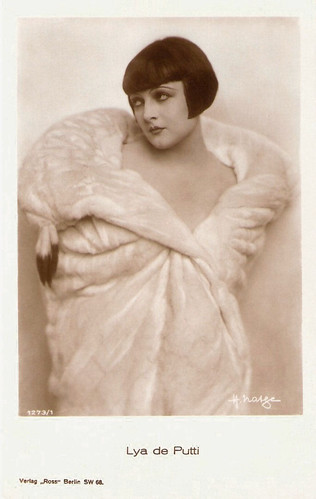
German postcard by Ross Verlag, Berlin, no. 1273/1, 1927-1928. Photo: Hans Natge.
Hungarian-born film star Lya de Putti (1899-1931) portrayed vamps in German and American silent films.
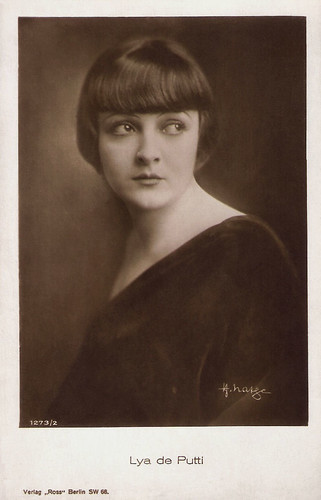
German postcard by Ross Verlag, no. 1273/2, 1927-1928. Photo: Hans Natge.
Several roles in the realm of cameras, directing and assistant directing
Hans Karl Heinrich Natge was born in Berlin in 1893. Natge was very involved in German silent film production, especially at the Ufa. During the 1920s, he played several roles in the realm of cameras, directing and assistant directing. His filmography on IMDb reports that he has 28 film credits between 1924 and 1949. Nineteen of these credits were for his role as the film’s 'still photographer'.
Natge worked as a still photographer for Friedrich Wilhelm Murnau on his masterpieces Der letzte Mann (Friedrich Wilhelm Murnau, 1924) and Faust (Friedrich Wilhelm Murnau, 1926). Besides etheric portraits of the young Camilla Horn who played Gretchen in Faust, Natge also made photo portraits of director Murnau himself.
For another great Weimar film-maker, Ewald Andre Dupont, he made stills for Das alte Gesetz (E.A. Dupont, 1923) with Henny Porten and the classic Moulin Rouge (Ewald André Dupont, 1928). Dupont took almost a year to make Moulin Rouge at a production cost of $500,000, a huge amount for 1928. Natge made portraits of the French leading man of the film, Jean Bradin. He also made the still photographs for another film with German diva Henny Porten, Liebe im Kuhstall/Love in the Cowshed (Carl Froelich, 1928).
In the early 1930s, Hans Natge also made a few films as an assistant director or co-director. These included Es kommt alle Tage vor... (Hans Natge, Adolf Trotz, 1930) starring Walter Rilla and Das Lied der Schwarzen Berge/Fantom Durmitora/The Song of the Black Mountains (K. Breiness, Hans Natge, 1933) starring Ita Rina .
As a still photographer, Hans Natge steadily worked during the 1930s and early 1940s on such light entertainment films as Ein Lied, ein Kuß, ein Mädel/A Song, A Kiss, A Girl (Géza von Bolváry, 1930) starring Marta Eggerth and Die göttliche Jette/The divine Jetta (Erich Waschneck, 1937) starring Grethe Weiser. According to IMDb , his final film was Willi Forst's Wiener Mädeln/Viennese Girls (1949). The film was begun in 1944, but not completed until 1949.
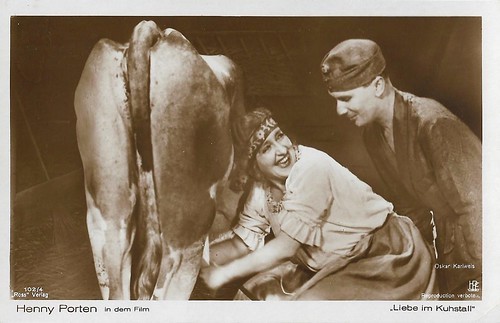
German postcard by Ross Verlag, no. 102/4. Photo: Henny Porten Freuhlich-Produktion. Henny Porten and Oskar Karlweiss in Liebe im Kuhstall/Love in the Cowshed (Carl Froelich, 1928).
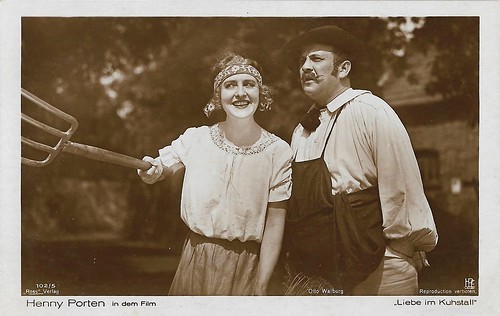
German postcard by Ross Verlag, no. 102/5. Photo: Henny Porten Freuhlich-Produktion. Henny Porten and Otto Wallburg in Liebe im Kuhstall/Love in the Cowshed (Carl Froelich, 1928).
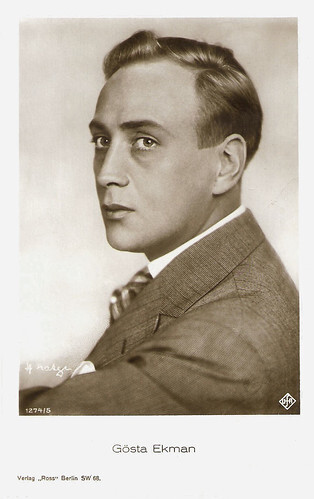
German postcard by Ross Verlag, no. 1274/5, 1927-1928. Photo: Hans Natge / Ufa.
Gösta Ekman (1890–1938) was the first real star of the Swedish theatre. His boyish good looks attracted both sexes, helping to create a massive cult following and elevating him to the status of a living legend. Combined with a beautiful voice and a powerful stage and screen presence, Ekman was able to captivate his audiences.
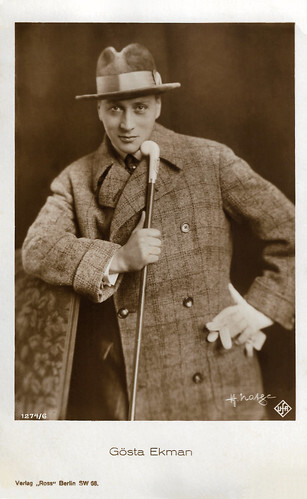
German postcard by Ross Verlag, Berlin, no. 1274/6. Photo: Hans Natge / Ufa.
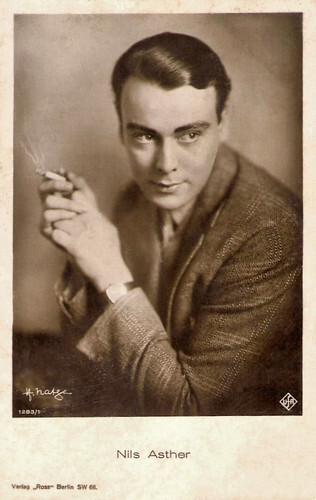
German Postcard by Ross Verlag, Berlin, no. 1283/1, 1927-1928. Photo: Hans Natge / Ufa.
Good-looking Swedish actor Nils Asther (1897-1981) was an intense star of silent European cinema. In Hollywood, he was the leading man of stars like Pola Negri, Greta Garbo and Marion Davies and was labelled ‘the male Greta Garbo’.
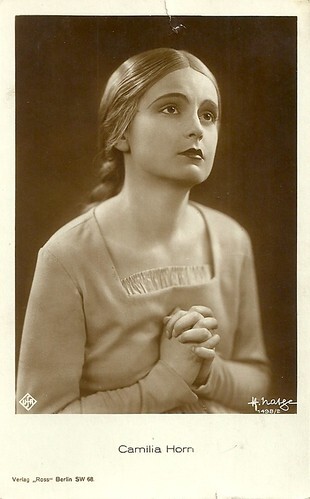
German postcard by Ross Verlag, no. 1498/2. Photo: Hans Natge / Ufa. Camilla Horn in Faust (Friedrich Wilhelm Murnau, 1926).
Ethereally blonde Camilla Horn (1903-1996) was a German dancer and film star. Her breakthrough role was Gretchen in the silent film classic Faust (Friedrich Wilhelm Murnau, 1926). She also starred in some Hollywood films of the late 1920s and in a few British and Italian productions.
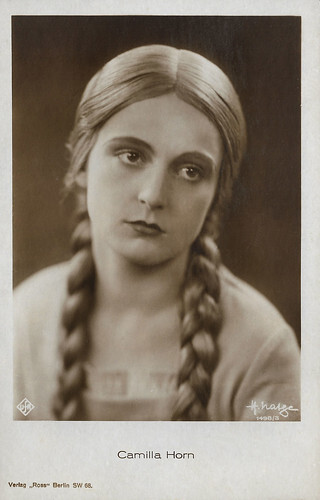
German postcard by Ross Verlag, no. 1498/3. Photo Hans Natge / Ufa. Camilla Horn in Faust (Friedrich Wilhelm Murnau, 1926).
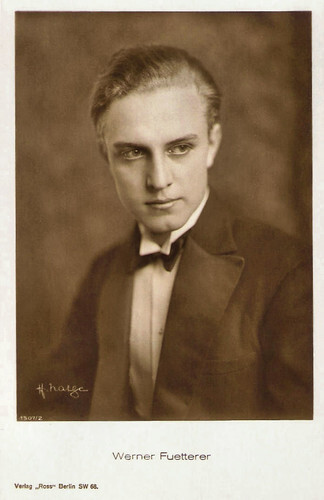
German postcard by Ross Verlag, Berlin, no. 1507/2, 1927-1928. Photo: Hans Natge.
At the age of 18, German actor Werner Fuetterer (1907-1991) was discovered to play the young lover in a series of silent films. For more than four decades he went on to work as a supporting actor in nearly 100 films.
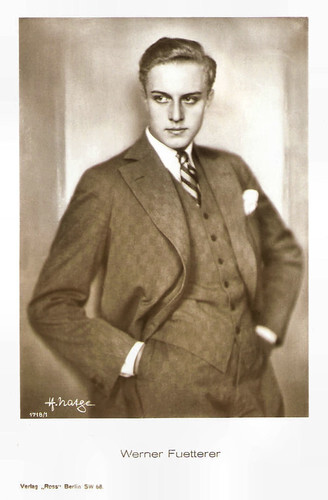
German postcard by Ross Verlag, Berlin, no. 1718/1, 1927-1928. Photo: Hans Natge.
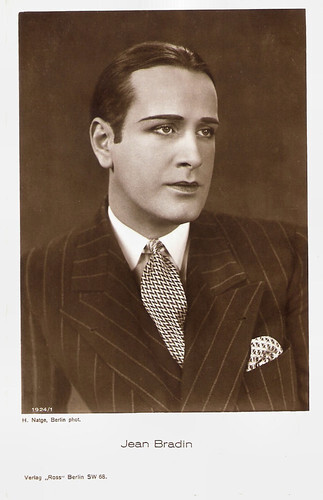
German postcard by Ross Verlag, Berlin, no. 1924/1, 1927-1928. Photo: Hans Natge.
Very few personal facts are known about French actor Jean Bradin (1899-1969). Yet, he was a prolific film actor from the early 1920s onward, acting first in French and also afterwards in German and British films, including Hitchcock's Champagne (1928) and Dupont's Moulin Rouge (1928).
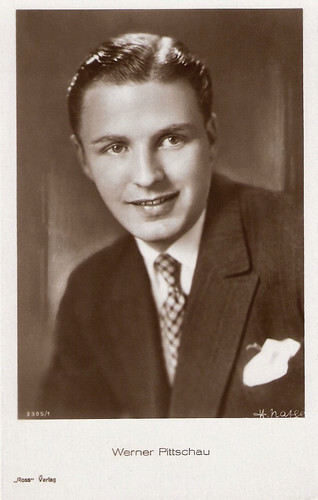
German postcard by Ross Verlag, no. 3305/1, 1928-1929. Photo: Hans Natge.
Handsome actor Werner Pittschau (1902-1928) was the promising Jeune premier of the silent Austrian cinema. Sadly he was killed in a road accident at the age of 26.
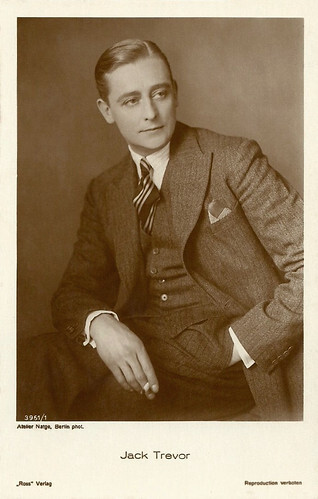
German postcard by Ross Verlag no. 3961/1, 1928-1929. Photo: Atelier Natge, Berlin.
British gentleman actor Jack Trevor (1890-1976) had a great career in the German and Austrian silent cinema of the 1920s but during World War II he was forced by the Nazis to appear in Anti-English propaganda films.
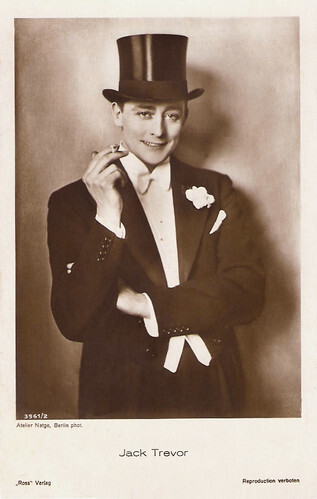
German postcard by Ross Verlag, no. 3961/2, 1928-1929. Photo: Atelier Natge, Berlin.
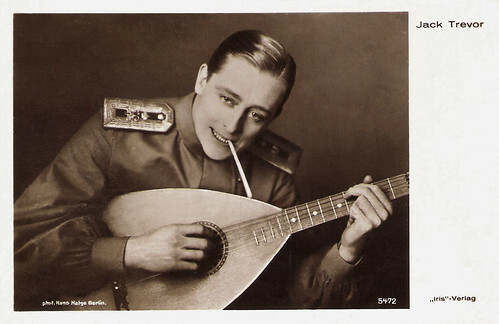
Austrian postcard by Iris Verlag, no. 5472. Photo: Hans Natge, Berlin.
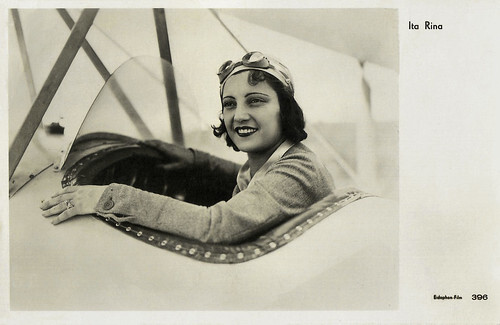
Dutch postcard by JosPe, no. 396. Photo: Eidophon-Film. Ita Rina in Das Lied der Schwarzen Berge/Fantom Durmitora/The Song of the Black Mountains (K. Breiness, Hans Natge, 1933).
Yugoslav film actress and beauty queen Ita Rina (1907-1979) was one of the major film stars in Germany and Czechoslovakia in the late 1920s and early 1930s.
Sources: The Cabinet Card Gallery and .

German postcard by Ross Verlag, Berlin, no. 66/1. Photo: Ufa. Camilla Horn in Faust (Friedrich Wilhelm Murnau, 1926).

German postcard by Ross Verlag, no. 62/5. Photo: ParUfaMet / Ufa. Gösta Ekman in Faust (F.W. Murnau, 1926).

German postcard by Ross Verlag, no. 663/1. Photo: Hans Natge, Berlin / Comedia Film. Henny Porten in Das alte Gesetz (E.A. Dupont, 1923).
Sturdy and blond Henny Porten (1890-1960) was one of Germany's most important and popular film actresses of silent cinema. She became the quintessence of German womanhood, ladylike yet kindhearted and a not a little petit bourgeois. She was also the producer of many of her own films.

German postcard by Ross Verlag, no. 663/2. Photo: Hans Natge, Berlin / Comedia Film. Henny Porten and Ernst Deutsch in Das alte Gesetz (E.A. Dupont, 1923).

German postcard by Ross Verlag, no. 663/5. Photo: Hans Natge, Berlin. Henny Porten in Das alte Gesetz (E.A. Dupont, 1923).

German postcard by Ross Verlag, Berlin, no. 1272/2, 1927-1928. Photo: Hans Natge.
Conrad Veidt (1893–1943) was the most highly strung and romantically handsome of the German expressionist actors. From 1916 until his death, he appeared in well over 100 films, including such classics as Das Kabinett des Dr. Caligari/Das Cabinet des Dr. Caligari (Robert Wiene, 1920) and Casablanca (Michael Curtiz, 1942).

German postcard by Ross Verlag, Berlin, no. 1273/1, 1927-1928. Photo: Hans Natge.
Hungarian-born film star Lya de Putti (1899-1931) portrayed vamps in German and American silent films.

German postcard by Ross Verlag, no. 1273/2, 1927-1928. Photo: Hans Natge.
Several roles in the realm of cameras, directing and assistant directing
Hans Karl Heinrich Natge was born in Berlin in 1893. Natge was very involved in German silent film production, especially at the Ufa. During the 1920s, he played several roles in the realm of cameras, directing and assistant directing. His filmography on IMDb reports that he has 28 film credits between 1924 and 1949. Nineteen of these credits were for his role as the film’s 'still photographer'.
Natge worked as a still photographer for Friedrich Wilhelm Murnau on his masterpieces Der letzte Mann (Friedrich Wilhelm Murnau, 1924) and Faust (Friedrich Wilhelm Murnau, 1926). Besides etheric portraits of the young Camilla Horn who played Gretchen in Faust, Natge also made photo portraits of director Murnau himself.
For another great Weimar film-maker, Ewald Andre Dupont, he made stills for Das alte Gesetz (E.A. Dupont, 1923) with Henny Porten and the classic Moulin Rouge (Ewald André Dupont, 1928). Dupont took almost a year to make Moulin Rouge at a production cost of $500,000, a huge amount for 1928. Natge made portraits of the French leading man of the film, Jean Bradin. He also made the still photographs for another film with German diva Henny Porten, Liebe im Kuhstall/Love in the Cowshed (Carl Froelich, 1928).
In the early 1930s, Hans Natge also made a few films as an assistant director or co-director. These included Es kommt alle Tage vor... (Hans Natge, Adolf Trotz, 1930) starring Walter Rilla and Das Lied der Schwarzen Berge/Fantom Durmitora/The Song of the Black Mountains (K. Breiness, Hans Natge, 1933) starring Ita Rina .
As a still photographer, Hans Natge steadily worked during the 1930s and early 1940s on such light entertainment films as Ein Lied, ein Kuß, ein Mädel/A Song, A Kiss, A Girl (Géza von Bolváry, 1930) starring Marta Eggerth and Die göttliche Jette/The divine Jetta (Erich Waschneck, 1937) starring Grethe Weiser. According to IMDb , his final film was Willi Forst's Wiener Mädeln/Viennese Girls (1949). The film was begun in 1944, but not completed until 1949.

German postcard by Ross Verlag, no. 102/4. Photo: Henny Porten Freuhlich-Produktion. Henny Porten and Oskar Karlweiss in Liebe im Kuhstall/Love in the Cowshed (Carl Froelich, 1928).

German postcard by Ross Verlag, no. 102/5. Photo: Henny Porten Freuhlich-Produktion. Henny Porten and Otto Wallburg in Liebe im Kuhstall/Love in the Cowshed (Carl Froelich, 1928).

German postcard by Ross Verlag, no. 1274/5, 1927-1928. Photo: Hans Natge / Ufa.
Gösta Ekman (1890–1938) was the first real star of the Swedish theatre. His boyish good looks attracted both sexes, helping to create a massive cult following and elevating him to the status of a living legend. Combined with a beautiful voice and a powerful stage and screen presence, Ekman was able to captivate his audiences.

German postcard by Ross Verlag, Berlin, no. 1274/6. Photo: Hans Natge / Ufa.

German Postcard by Ross Verlag, Berlin, no. 1283/1, 1927-1928. Photo: Hans Natge / Ufa.
Good-looking Swedish actor Nils Asther (1897-1981) was an intense star of silent European cinema. In Hollywood, he was the leading man of stars like Pola Negri, Greta Garbo and Marion Davies and was labelled ‘the male Greta Garbo’.

German postcard by Ross Verlag, no. 1498/2. Photo: Hans Natge / Ufa. Camilla Horn in Faust (Friedrich Wilhelm Murnau, 1926).
Ethereally blonde Camilla Horn (1903-1996) was a German dancer and film star. Her breakthrough role was Gretchen in the silent film classic Faust (Friedrich Wilhelm Murnau, 1926). She also starred in some Hollywood films of the late 1920s and in a few British and Italian productions.

German postcard by Ross Verlag, no. 1498/3. Photo Hans Natge / Ufa. Camilla Horn in Faust (Friedrich Wilhelm Murnau, 1926).

German postcard by Ross Verlag, Berlin, no. 1507/2, 1927-1928. Photo: Hans Natge.
At the age of 18, German actor Werner Fuetterer (1907-1991) was discovered to play the young lover in a series of silent films. For more than four decades he went on to work as a supporting actor in nearly 100 films.

German postcard by Ross Verlag, Berlin, no. 1718/1, 1927-1928. Photo: Hans Natge.

German postcard by Ross Verlag, Berlin, no. 1924/1, 1927-1928. Photo: Hans Natge.
Very few personal facts are known about French actor Jean Bradin (1899-1969). Yet, he was a prolific film actor from the early 1920s onward, acting first in French and also afterwards in German and British films, including Hitchcock's Champagne (1928) and Dupont's Moulin Rouge (1928).

German postcard by Ross Verlag, no. 3305/1, 1928-1929. Photo: Hans Natge.
Handsome actor Werner Pittschau (1902-1928) was the promising Jeune premier of the silent Austrian cinema. Sadly he was killed in a road accident at the age of 26.

German postcard by Ross Verlag no. 3961/1, 1928-1929. Photo: Atelier Natge, Berlin.
British gentleman actor Jack Trevor (1890-1976) had a great career in the German and Austrian silent cinema of the 1920s but during World War II he was forced by the Nazis to appear in Anti-English propaganda films.

German postcard by Ross Verlag, no. 3961/2, 1928-1929. Photo: Atelier Natge, Berlin.

Austrian postcard by Iris Verlag, no. 5472. Photo: Hans Natge, Berlin.

Dutch postcard by JosPe, no. 396. Photo: Eidophon-Film. Ita Rina in Das Lied der Schwarzen Berge/Fantom Durmitora/The Song of the Black Mountains (K. Breiness, Hans Natge, 1933).
Yugoslav film actress and beauty queen Ita Rina (1907-1979) was one of the major film stars in Germany and Czechoslovakia in the late 1920s and early 1930s.
Sources: The Cabinet Card Gallery and .
Published on October 20, 2023 22:00
October 19, 2023
Cleo Moore
American actress Cleo Moore (1924-1973) was a well-known pin-up girl and a platinum blonde bombshell in Hollywood films of the 1950s. She made seven B-films with Hugo Haas. Although she never became a true film star, Moore is now a cult favourite as one of the 'Bad Girls of Film Noir'.

British postcard in the Greetings series. Photo: Universal-International.
The Blonde Rita Hayworth
Cleouna Moore was born in Galvez, Louisiana, in 1924 (Wikipedia writes 1929) and raised in nearby Gonzales. Her father ran a grocery store there and was later a building contractor. She had three sisters: Mari, Voni, and Jonnie. Cleo was educated in Gonzales public schools and took a secretarial course at Pope's Commercial College in Baton Rouge.
In 1944, she married Palmer Long, the youngest child of Huey Long, the former governor of Louisiana who was assassinated five years earlier while a Senator for Louisiana. However, the marriage ended in six weeks. After Cleo finished high school, she moved with her family to California where her father was anticipating the end of World War II and the building boom that was expected to follow.
Moore was named Miss Van Nuys from 1947 to 1948. She was spotted by an RKO executive and was convinced to take a screen test. In 1948, she made her film debut in Embraceable You (Felix Jacoves, 1948) and also played the leading lady in the film serial Congo Bill (Spencer Gordon Bennet, Thomas Carr, 1948), based on the DC Comics character Congo Bill. After that fiasco, Cleo went back to work at her family's building business and did some modelling.
In 1950, she worked briefly for Warner Brothers, and from 1950 to 1952, for RKO Radio Pictures. For RKO, she made such films as the Film Noir Hunt the Man Down (George Archainbaud, 1951) with Gig Young, and Gambling House (Ted Tetzlaff, 1951) starring Victor Mature . She signed with Columbia Pictures in 1952. The studio had plans to mould Moore as its next film star, hoping she would bring Columbia the success that 20th Century Fox was having with Marilyn Monroe . In order to compete with Monroe, Moore had to bleach her hair platinum blonde. Columbia dubbed her "The Next Big Thing" and "The Blonde Rita Hayworth". She first gained attention as a doomed gun moll in Nicholas Ray's Film Noir On Dangerous Ground (1952) with Ida Lupino and Robert Ryan , but it was still a minor part.
Moore began starring in films and the following year, she made one of her most remembered films, the low-budget Film Noir One Girl's Confession (Hugo Haas, 1953), opposite Haas himself. Hugo Haas directed and appeared with her in several other films in which he played an older man ruined by Moore's seductive charms. She co-starred in Thy Neighbor's Wife (Hugo Haas, 1953) and Bait (Hugo Haas, 1954), the latter co-starring John Agar. In 1954, she starred in The Other Woman (Hugo Haas, 1954), playing a B-movie bit player who strikes at a film director when he declines to offer her a role in his picture. In 1954, Moore's career began to fade in the eyes of Columbia. The studio signed newcomer Kim Novak to a contract and started moulding Novak as its new star on the lot. Moore was cast in forgettable B-movies including a supporting role in Women's Prison (Lewis Seiler, 1955) with Ida Lupino , which fared well at the box office.
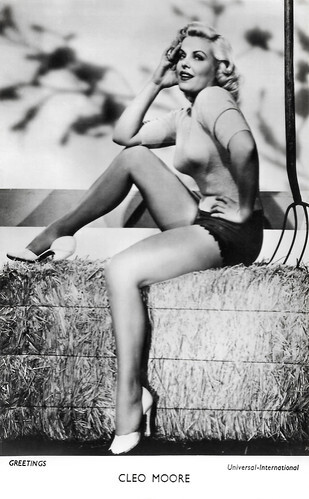
British postcard in the Greetings series. Photo: Universal-International.
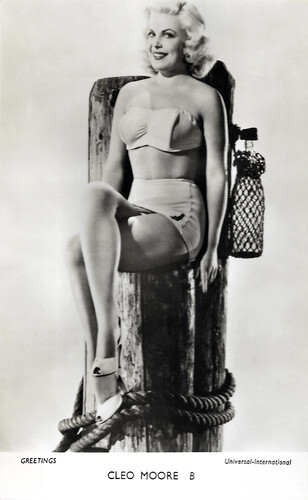
British postcard in the Greetings series, no. B. Photo: Universal-International.
Publicity stunts
Cleo Moore signed a brief deal with Universal Pictures to play a suicidal prostitute in the low-budget thriller Hold Back Tomorrow (Hugo Haas, 1955), again opposite John Agar. In 1956, she starred as a predatory career girl in Over-Exposed (Lewis Seiler, 1956), co-starring Richard Crenna.
The following year, Moore made her final film appearance in Hit and Run (Hugo Haas, 1957) with Vince Edwards and her sister, Mara Lea. She had star billing, but it was another box-office bomb and Moore retired from acting.
Despite never achieving true film stardom, Moore made headlines with several publicity stunts. In 1954, she caused a scandal while doing a live Chicago TV promotional kiss with Jack Eigen, radio and TV veteran for ABC affiliate WBKB, in what he terms an experiment testing the reaction of TV audiences. The kiss lasted approximately 5 minutes and 17 seconds. Both were sitting in separate seats and Eigen was fired after protests from hundreds of women viewers. In 1955, she announced on an NBC talk show that she would eventually run for governor of Louisiana. The following year, she repeated that she would do so in 1960. But of course, she never did.
Instead, Moore found success as a businesswoman in real estate after her screen career had ended. After her six-week marriage, at age 15, to Palmer Long, Cleo Moore remained single through the 1940s and 1950s. In 1961, she married multi-millionaire real estate developer Herbert Heftler and lived on an estate on Coldwater Canyon in Beverly Hills for the remaining 12 years of her life.
Cleouna M. Heftler died in her sleep of a heart attack at the age of 48 in 1973. She is interred at Inglewood Park Cemetery, Inglewood, California. She had a daughter named Debra Lee Heftler (1963). After her sudden death, Cleo Moore began to attract a cult following in the 1980s with airings of her bad-girl movies on television. In the 1990s, Sony Pictures released three Moore titles — Over-Exposed, One Girl's Confession, and Women's Prison — in a DVD set entitled 'Bad Girls of Film Noir Volume II'.

Belgian collectors card by Merbotex, Bruxelles, for Metro, Niel, no. 19. Photo: Universal.
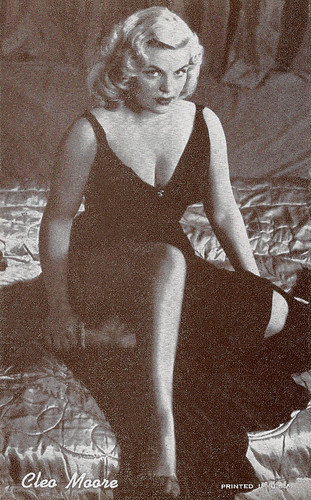
American Arcade postcard.
Sources: Denny Jackson (), Hal Erickson (AllMovie), Glamour Girls of the Silver Screen, Wikipedia, and .

British postcard in the Greetings series. Photo: Universal-International.
The Blonde Rita Hayworth
Cleouna Moore was born in Galvez, Louisiana, in 1924 (Wikipedia writes 1929) and raised in nearby Gonzales. Her father ran a grocery store there and was later a building contractor. She had three sisters: Mari, Voni, and Jonnie. Cleo was educated in Gonzales public schools and took a secretarial course at Pope's Commercial College in Baton Rouge.
In 1944, she married Palmer Long, the youngest child of Huey Long, the former governor of Louisiana who was assassinated five years earlier while a Senator for Louisiana. However, the marriage ended in six weeks. After Cleo finished high school, she moved with her family to California where her father was anticipating the end of World War II and the building boom that was expected to follow.
Moore was named Miss Van Nuys from 1947 to 1948. She was spotted by an RKO executive and was convinced to take a screen test. In 1948, she made her film debut in Embraceable You (Felix Jacoves, 1948) and also played the leading lady in the film serial Congo Bill (Spencer Gordon Bennet, Thomas Carr, 1948), based on the DC Comics character Congo Bill. After that fiasco, Cleo went back to work at her family's building business and did some modelling.
In 1950, she worked briefly for Warner Brothers, and from 1950 to 1952, for RKO Radio Pictures. For RKO, she made such films as the Film Noir Hunt the Man Down (George Archainbaud, 1951) with Gig Young, and Gambling House (Ted Tetzlaff, 1951) starring Victor Mature . She signed with Columbia Pictures in 1952. The studio had plans to mould Moore as its next film star, hoping she would bring Columbia the success that 20th Century Fox was having with Marilyn Monroe . In order to compete with Monroe, Moore had to bleach her hair platinum blonde. Columbia dubbed her "The Next Big Thing" and "The Blonde Rita Hayworth". She first gained attention as a doomed gun moll in Nicholas Ray's Film Noir On Dangerous Ground (1952) with Ida Lupino and Robert Ryan , but it was still a minor part.
Moore began starring in films and the following year, she made one of her most remembered films, the low-budget Film Noir One Girl's Confession (Hugo Haas, 1953), opposite Haas himself. Hugo Haas directed and appeared with her in several other films in which he played an older man ruined by Moore's seductive charms. She co-starred in Thy Neighbor's Wife (Hugo Haas, 1953) and Bait (Hugo Haas, 1954), the latter co-starring John Agar. In 1954, she starred in The Other Woman (Hugo Haas, 1954), playing a B-movie bit player who strikes at a film director when he declines to offer her a role in his picture. In 1954, Moore's career began to fade in the eyes of Columbia. The studio signed newcomer Kim Novak to a contract and started moulding Novak as its new star on the lot. Moore was cast in forgettable B-movies including a supporting role in Women's Prison (Lewis Seiler, 1955) with Ida Lupino , which fared well at the box office.

British postcard in the Greetings series. Photo: Universal-International.

British postcard in the Greetings series, no. B. Photo: Universal-International.
Publicity stunts
Cleo Moore signed a brief deal with Universal Pictures to play a suicidal prostitute in the low-budget thriller Hold Back Tomorrow (Hugo Haas, 1955), again opposite John Agar. In 1956, she starred as a predatory career girl in Over-Exposed (Lewis Seiler, 1956), co-starring Richard Crenna.
The following year, Moore made her final film appearance in Hit and Run (Hugo Haas, 1957) with Vince Edwards and her sister, Mara Lea. She had star billing, but it was another box-office bomb and Moore retired from acting.
Despite never achieving true film stardom, Moore made headlines with several publicity stunts. In 1954, she caused a scandal while doing a live Chicago TV promotional kiss with Jack Eigen, radio and TV veteran for ABC affiliate WBKB, in what he terms an experiment testing the reaction of TV audiences. The kiss lasted approximately 5 minutes and 17 seconds. Both were sitting in separate seats and Eigen was fired after protests from hundreds of women viewers. In 1955, she announced on an NBC talk show that she would eventually run for governor of Louisiana. The following year, she repeated that she would do so in 1960. But of course, she never did.
Instead, Moore found success as a businesswoman in real estate after her screen career had ended. After her six-week marriage, at age 15, to Palmer Long, Cleo Moore remained single through the 1940s and 1950s. In 1961, she married multi-millionaire real estate developer Herbert Heftler and lived on an estate on Coldwater Canyon in Beverly Hills for the remaining 12 years of her life.
Cleouna M. Heftler died in her sleep of a heart attack at the age of 48 in 1973. She is interred at Inglewood Park Cemetery, Inglewood, California. She had a daughter named Debra Lee Heftler (1963). After her sudden death, Cleo Moore began to attract a cult following in the 1980s with airings of her bad-girl movies on television. In the 1990s, Sony Pictures released three Moore titles — Over-Exposed, One Girl's Confession, and Women's Prison — in a DVD set entitled 'Bad Girls of Film Noir Volume II'.

Belgian collectors card by Merbotex, Bruxelles, for Metro, Niel, no. 19. Photo: Universal.

American Arcade postcard.
Sources: Denny Jackson (), Hal Erickson (AllMovie), Glamour Girls of the Silver Screen, Wikipedia, and .
Published on October 19, 2023 22:00
October 18, 2023
Joe E. Brown
American comedian Joe E. Brown (1891-1973) is dearly remembered for his portrayal as Osgood Fielding III in Billy Wilder's Some Like It Hot (1959), in which he utters the famous punchline "Well, nobody's perfect". With his amiable screen persona, comic timing, and enormous elastic-mouth smile, Brown was one of the most popular American comedians in the 1930s and 1940s, with successful films like A Midsummer Night's Dream (1935), Earthworm Tractors (1936) and Alibi Ike (1935).
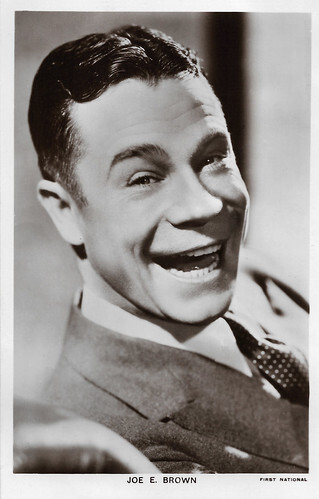
British postcard in the Picturegoer Series, London, no. 480a. Photo: First National.
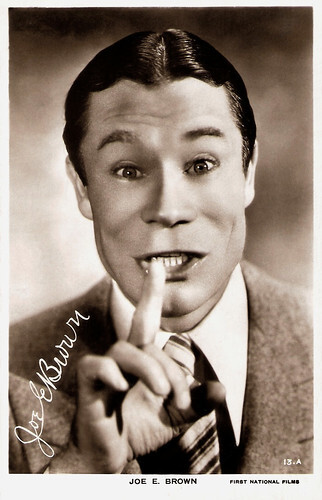
British Real Photograph postcard, no. 13. A. Photo: First National.
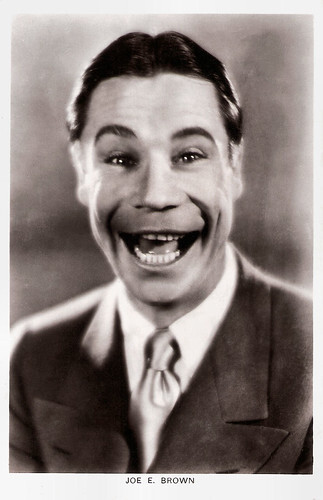
British postcard in the Picturegoer Series, London, no. 480.
Encouraged to run away with the circus
Joseph Evans Brown was born in Holgate, Ohio, in 1891 (according to IMDb 1892).
One of his proudest claims was that he was perhaps the only kid whose parents encouraged him to run away with the circus. In 1902, the 10-year-old Brown joined a circus tumbling act called the Five Marvellous Ashtons, with whom he started his vaudeville career.
He toured in burlesque in an acrobatic act, and also briefly played semi-professional baseball. His avid interest in baseball inaugurated a lifelong association with that sport which would include his participation in the National Vaudeville Artists ball team, his part-ownership of the minor league Kansas City Blues, and his providing pregame 'colour' for the televised New York Yankees games of the 1950s (Joe's son Joe L. became manager of the Pittsburgh Pirates in 1955).
On the verge of leaving vaudeville for Broadway in 1919, Joe discovered that Actors' Equity had called a strike; with very little hesitation, he grabbed a sign and joined the picket line. In 1920, Brown finally made it to Broadway as a comedian in the all-star review 'Jim Jam Jems'.
He went on to star in such New York productions as 'Captain Jinks' and 'Twinkle Twinkle'. In 1927, he began his film career in the short comedy Twinkle, Twinkle (1927). Uncharacteristically he appeared in turgid melodramas like Crooks Can't Win (George M. Arthur, 1928) until he was signed by Warner Bros. in 1929.
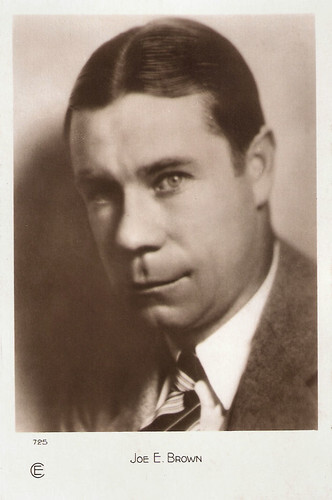
French postcard by Cinémagazine-Edition, Paris, no. 725.
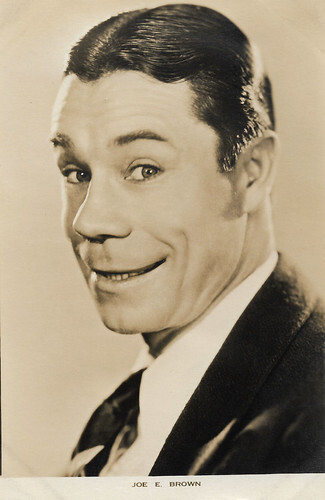
British postcard by Film Weekly, London.
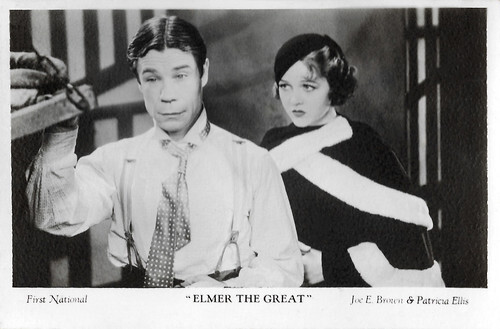
British postcard by Film Weekly, London. Photo: First national. Joe E. Brown and Patricia Ellis in Elmer, the Great (Mervyn LeRoy, 1933).
His huge mouth, cavernous grin, and drawn-out yell
Joe E. Brown became a favourite with child audiences and shot to stardom after appearing in the first all-colour all-talking musical comedy On with the Show (Alan Crosland, 1929). He starred in several lavish Technicolor Warner Brothers musical comedies including Sally (John Francis Dillon, 1929), Hold Everything (Roy Del Ruth, 1930), Song of the West (Ray Enright, 1930), and Going Wild (William A. Seiter, 1930).
In his popular Warners vehicles, Joe E. Brown alternated between playing naive young men who made good despite impossible odds, or brash braggarts who had to be taken down a peg or two. His trademark was his huge mouth, cavernous grin, and drawn-out yell.
Joe's best films were those in which he was permitted to display his athletic prowess, such as his 'baseball trilogy' Fireman Save My Child (Lloyd Bacon, 1932), Elmer the Great (Mervyn LeRoy, 1933) and Alibi Ike (Ray Enright, 1935).
Personally selected by Max Reinhardt to play Flute in the lavish Warners adaptation of William Shakespeare 's A Midsummer Night's Dream (Max Reinhardt, William Dieterle, 1935), Brown easily stole the show from such formidable competition as James Cagney , Olivia de Havilland , Victor Jory, and Mickey Rooney . Another hit was Earthworm Tractors (Ray Enright, 1936).
During his Warner years, Brown and his wife began sponsoring promising college athletes: among Joe's proteges were UCLA football star (and later producer) Mike Frankovitch, and Olympic contestant (and future politician) Ralph Metcalfe. After ending his Warners contract in 1936, Brown starred for independent producer David Loew in When's Your Birthday? (Bob Clampett, Leon Schlesinger, 1937) and The Gladiator (Edward Sedgwick, 1938). In 1939, Brown testified before the House Immigration Committee in support of a bill that would allow 20,000 German Jewish refugee children into the US. He later adopted two refugee children.
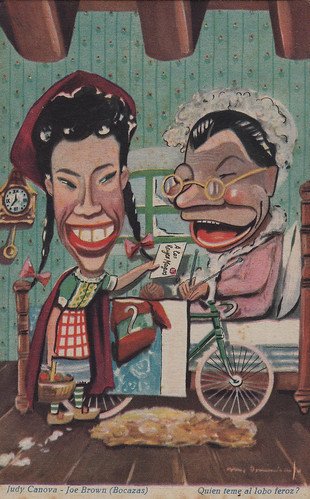
Spanish postcard. Judy Canova and Joe E. Brown. Caption: Who's afraid of the fierce wolf? Collection: Marlene Pilaete.
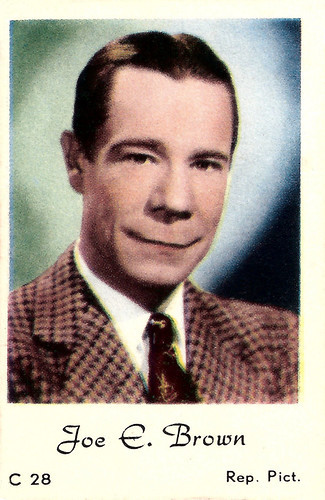
Small collectors card, no. C 28. Photo: Republic Pictures.
Daffy millionaire Osgood Fielding III
By the early 1940s, Joe E. Brown's pictures were strictly in the 'B' category, though some of them, notably his brace of co-starring assignments with comedienne Judy Canova, had glimmers of the old Brown magic. He worked tirelessly entertaining troops in all corners of the world during World War II; their enthusiastic response enabled Brown to overcome the death of his son, Captain Donald Evans Brown, in a training accident.
After the war, Brown devoted most of his energies to stage work. In 1948, he was awarded a Special Tony Award for his work in the touring company of 'Harvey'. On-screen he played Captain Andy in the MGM remake of Show Boat (George Sidney, 1951) with Ava Gardner .
In 1961, he reprised the role on stage. He added television to his long list of accomplishments in the 1950s and 1960s. Most of Joe E. Brown's final film appearances were cameo roles, such as in Around the World in 80 Days (Michael Anderson, 1956), and It's a Mad, Mad, Mad, Mad World (Stanley Kramer, 1963).
The outstanding exception was his portrayal of daffy millionaire Osgood Fielding III in Some Like It Hot (Billy Wilder, 1959). Fielding falls for Daphne, played by Jack Lemmon in drag. At the end of the film, Lemmon takes off his wig and reveals to Brown that he is a man, to which Brown brings down the house by uttering the film's classic punchline: "Well, nobody's perfect."
Brown began having heart problems in 1968, after suffering a severe heart attack and underwent cardiac surgery. He died from arteriosclerosis in 1973 at his home in Brentwood, Los Angeles, California, three weeks before his 82nd birthday.
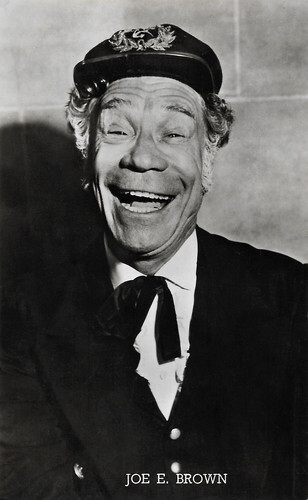
Vintage postcard, no. 383. Joe E. Brown in Show Boat (George Sidney, 1951).
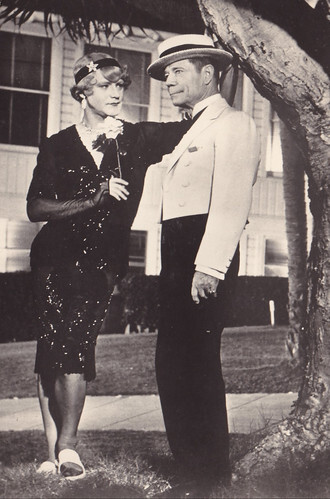
Czech postcard by Pressfoto, Praha (Prague). Photo: Jack Lemmon and Joe E. Brown in Some Like it Hot (Billy Wilder, 1959). Collection: Carla Bosch.
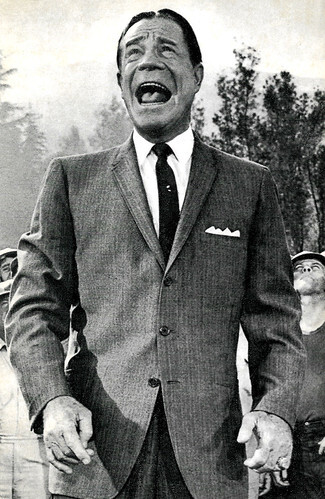
Romanian postcard by Casa Filmului Acin, no. 38. Photo: Joe E. Brown in It's a Mad Mad Mad Mad World (Stanley Kramer, 1963).
Sources: Hal Erickson (AllMovie), Wikipedia and .

British postcard in the Picturegoer Series, London, no. 480a. Photo: First National.

British Real Photograph postcard, no. 13. A. Photo: First National.

British postcard in the Picturegoer Series, London, no. 480.
Encouraged to run away with the circus
Joseph Evans Brown was born in Holgate, Ohio, in 1891 (according to IMDb 1892).
One of his proudest claims was that he was perhaps the only kid whose parents encouraged him to run away with the circus. In 1902, the 10-year-old Brown joined a circus tumbling act called the Five Marvellous Ashtons, with whom he started his vaudeville career.
He toured in burlesque in an acrobatic act, and also briefly played semi-professional baseball. His avid interest in baseball inaugurated a lifelong association with that sport which would include his participation in the National Vaudeville Artists ball team, his part-ownership of the minor league Kansas City Blues, and his providing pregame 'colour' for the televised New York Yankees games of the 1950s (Joe's son Joe L. became manager of the Pittsburgh Pirates in 1955).
On the verge of leaving vaudeville for Broadway in 1919, Joe discovered that Actors' Equity had called a strike; with very little hesitation, he grabbed a sign and joined the picket line. In 1920, Brown finally made it to Broadway as a comedian in the all-star review 'Jim Jam Jems'.
He went on to star in such New York productions as 'Captain Jinks' and 'Twinkle Twinkle'. In 1927, he began his film career in the short comedy Twinkle, Twinkle (1927). Uncharacteristically he appeared in turgid melodramas like Crooks Can't Win (George M. Arthur, 1928) until he was signed by Warner Bros. in 1929.

French postcard by Cinémagazine-Edition, Paris, no. 725.

British postcard by Film Weekly, London.

British postcard by Film Weekly, London. Photo: First national. Joe E. Brown and Patricia Ellis in Elmer, the Great (Mervyn LeRoy, 1933).
His huge mouth, cavernous grin, and drawn-out yell
Joe E. Brown became a favourite with child audiences and shot to stardom after appearing in the first all-colour all-talking musical comedy On with the Show (Alan Crosland, 1929). He starred in several lavish Technicolor Warner Brothers musical comedies including Sally (John Francis Dillon, 1929), Hold Everything (Roy Del Ruth, 1930), Song of the West (Ray Enright, 1930), and Going Wild (William A. Seiter, 1930).
In his popular Warners vehicles, Joe E. Brown alternated between playing naive young men who made good despite impossible odds, or brash braggarts who had to be taken down a peg or two. His trademark was his huge mouth, cavernous grin, and drawn-out yell.
Joe's best films were those in which he was permitted to display his athletic prowess, such as his 'baseball trilogy' Fireman Save My Child (Lloyd Bacon, 1932), Elmer the Great (Mervyn LeRoy, 1933) and Alibi Ike (Ray Enright, 1935).
Personally selected by Max Reinhardt to play Flute in the lavish Warners adaptation of William Shakespeare 's A Midsummer Night's Dream (Max Reinhardt, William Dieterle, 1935), Brown easily stole the show from such formidable competition as James Cagney , Olivia de Havilland , Victor Jory, and Mickey Rooney . Another hit was Earthworm Tractors (Ray Enright, 1936).
During his Warner years, Brown and his wife began sponsoring promising college athletes: among Joe's proteges were UCLA football star (and later producer) Mike Frankovitch, and Olympic contestant (and future politician) Ralph Metcalfe. After ending his Warners contract in 1936, Brown starred for independent producer David Loew in When's Your Birthday? (Bob Clampett, Leon Schlesinger, 1937) and The Gladiator (Edward Sedgwick, 1938). In 1939, Brown testified before the House Immigration Committee in support of a bill that would allow 20,000 German Jewish refugee children into the US. He later adopted two refugee children.

Spanish postcard. Judy Canova and Joe E. Brown. Caption: Who's afraid of the fierce wolf? Collection: Marlene Pilaete.

Small collectors card, no. C 28. Photo: Republic Pictures.
Daffy millionaire Osgood Fielding III
By the early 1940s, Joe E. Brown's pictures were strictly in the 'B' category, though some of them, notably his brace of co-starring assignments with comedienne Judy Canova, had glimmers of the old Brown magic. He worked tirelessly entertaining troops in all corners of the world during World War II; their enthusiastic response enabled Brown to overcome the death of his son, Captain Donald Evans Brown, in a training accident.
After the war, Brown devoted most of his energies to stage work. In 1948, he was awarded a Special Tony Award for his work in the touring company of 'Harvey'. On-screen he played Captain Andy in the MGM remake of Show Boat (George Sidney, 1951) with Ava Gardner .
In 1961, he reprised the role on stage. He added television to his long list of accomplishments in the 1950s and 1960s. Most of Joe E. Brown's final film appearances were cameo roles, such as in Around the World in 80 Days (Michael Anderson, 1956), and It's a Mad, Mad, Mad, Mad World (Stanley Kramer, 1963).
The outstanding exception was his portrayal of daffy millionaire Osgood Fielding III in Some Like It Hot (Billy Wilder, 1959). Fielding falls for Daphne, played by Jack Lemmon in drag. At the end of the film, Lemmon takes off his wig and reveals to Brown that he is a man, to which Brown brings down the house by uttering the film's classic punchline: "Well, nobody's perfect."
Brown began having heart problems in 1968, after suffering a severe heart attack and underwent cardiac surgery. He died from arteriosclerosis in 1973 at his home in Brentwood, Los Angeles, California, three weeks before his 82nd birthday.

Vintage postcard, no. 383. Joe E. Brown in Show Boat (George Sidney, 1951).

Czech postcard by Pressfoto, Praha (Prague). Photo: Jack Lemmon and Joe E. Brown in Some Like it Hot (Billy Wilder, 1959). Collection: Carla Bosch.

Romanian postcard by Casa Filmului Acin, no. 38. Photo: Joe E. Brown in It's a Mad Mad Mad Mad World (Stanley Kramer, 1963).
Sources: Hal Erickson (AllMovie), Wikipedia and .
Published on October 18, 2023 22:00
Paul van Yperen's Blog
- Paul van Yperen's profile
- 13 followers
Paul van Yperen isn't a Goodreads Author
(yet),
but they
do have a blog,
so here are some recent posts imported from
their feed.



